Cattle Make the Difference: Variations and Developments of Animal Husbandry in the Central European La Tène Culture
Abstract
Simple Summary
Abstract
1. Introduction
2. The Case Study of Haselbach (Lower Austria)
Materials and Methods
3. Results
3.1. Species Representation
3.2. Skeletal Element Representation
3.3. Age and Sex Distribution
3.4. Morphological Observations and Size Reconstruction
3.5. Modifications: Butchery Marks
4. Review of Archaeozoological Data from La Tène Sites in Central Europe
4.1. Species Representation
4.2. Sex and Age Distribution
4.2.1. Cattle
4.2.2. Sheep/Goat
4.2.3. Pig
4.3. Morphometric Analysis
4.3.1. Cattle
4.3.2. Sheep/Goat
4.3.3. Pig
4.3.4. Dog
4.3.5. Horse and Ass
5. Discussion
5.1. The Case Study of Haselbach
Husbandry and Exploitation of the Major Economic Domesticated Species (Cattle, Sheep/Goat, Pig) in Haselbach
Haselbach in the Broader Archaeozoological Context of La Tène Period Central Europe
5.2. Review of Archaeozoological Data from La Tène Sites in Central Europe
A Synthesis of the Archaeozoological Observations: Self-Sufficiency, Supply, Agricultural Intensification, and Animal Mobility
- Lowland settlements and central settlements
- Oppida
- Mining site
- Ritual contexts
5.3. Cattle Make the Difference: Patterns of Husbandry Based on Cattle Remains
5.4. A Last Aspect: Cynophagy and Hippophagy
6. Conclusions
- Concerning the new results from the medium-sized lowland settlement center of Haselbach, the analysis of the faunal remains suggests an economic organization different from smaller categories of lowland settlements. The prevalence of older castrated cattle (partly with pathologies) at Haselbach suggests that the demand for an animal workforce for plowing and transport considerably increased and that cattle from other (rural) settlements were delivered to the site, indicating increasing inter-dependencies and centralization of the settlement network. Additionally, the selection of young pigs further supports the urban character of the site of Haselbach. The data from Haselbach bear striking similarities to the large central settlement in Roseldorf, exhibiting a very similar archaeozoological profile and showing features of proto-urbanism.
- The observations from Haselbach fit very well with the detailed review of existing archaeozoological data from the Eastern La Tène Culture (55 faunal assemblages from 46 sites in nine countries). These data reveal faunistic changes in the composition, sex, and age profiles of domestic animals that indicate profound socio-economic changes during the Middle La Tène period. The prevalence of older male/castrated cattle in Haselbach is in accordance with profiles gained by other Middle La Tène sites, where a higher percentage of older male/castrated cattle was noted, suggesting a higher demand for labor animals. These gradual changes during the La Tène period could be associated with agricultural intensification, based on the increasing exploitation of labor animals. Finally, our review shows the crucial economic role of cattle for the La Tène period cultures and distinguishes several patterns of cattle husbandry, illustrating that cattle did make the difference.
Author Contributions
Funding
Institutional Review Board Statement
Informed Consent Statement
Data Availability Statement
Conflicts of Interest
References
- Collis, J. Oppida. Earliest Towns North of the Alps; University of Sheffield, Department of Prehistory and Archaeology: Sheffield, UK, 1984. [Google Scholar]
- Krauße, D.; Steffen, M. (Eds.) Frühe Zentralisierungs- und Urbanisierungsprozesse. Zur Genese und Entwicklung frühkeltischer Fürstensitze und ihres territorialen Umlandes. Kolloquium des DFG-Schwerpunktprogramms 1171 in Blaubeuren, 9–11 Oktober 2006; Konrad Theiss Verlag: Stuttgart, Germany, 2008; Volume 101. [Google Scholar]
- Collis, J.R. Zentralisierung und Urbanisierung in Europa nördlich der Alpen während der Eisenzeit. In “Fürstensitze” und Zentralorte der frühen Kelten. Abschlusskolloquium des DFG-Schwerpunktprogramms 1171 in Stuttgart, 12–15 Oktober 2009; Teil, I., Krauße, D., Beilharz, D., Eds.; Forschungen und Berichte zur Vor- und Frühgeschichte in Baden-Württemberg; Theiss: Stuttgart, Germany, 2010; Volume 120, pp. 77–91. [Google Scholar]
- Sievers, S.; Schönfelder, M. (Eds.) Die Frage der Protourbanisation in der Eisenzeit. La Question de la Proto-Urbanisation à l’âge du Fer. Akten des 34. Internationalen Kolloquiums der AFEAF vom 13–16. Mai 2010 in Aschaffenburg; Dr. Rudolf Habelt: Bonn, Germany, 2012; Volume 16. [Google Scholar]
- Fernández-Götz, M.; Wendling, H.; Winger, K. (Eds.) Paths to Complexity. Centralisation and Urbanisation in Iron Age Europe; Oxbow Books: Oxford, UK; Philadelphia, PA, USA, 2014. [Google Scholar]
- Gyucha, A.; Salisbury, R.B. (Eds.) The Archaeology of Nucleation in the Old World: Spatiality, Community, and Identity; Archaeopress: Oxford, UK, 2022. [Google Scholar]
- Březinova, G. Sídliská a sídliskové nálezy z laténskej doby na Juhozápadnom Slovensku (Siedlungen und Siedlungsfunde aus der Latènezeit in Südwestslowakei). Študijné Zvesti Archeologického Ústavu SAV 2006, 40, 9–50. [Google Scholar]
- Venclová, N. (Ed.) The Prehistory of Bohemia 6. The Late Iron Age—The La Tène Period; Archeologicky ustav: Praha, Czech Republic, 2013. [Google Scholar]
- Goláňová, P. The Early La Tène Period in Moravia; Habelt-Verlag: Bonn, Germany, 2018; Volume 32. [Google Scholar]
- Trebsche, P. Die latènezeitlichen Großsiedlungen im österreichischen Donauraum—Forschungsstand, Typologie und Überlegungen zur Genese. In Les agglomérations ouvertes de l’Europe celtique (IIIe-Ier s. av. J.-C.). Table ronde internationale Glux-en-Glenne, 28, 29 et 30 Octobre 2015. Offene Großsiedlungen im keltischen Europa (3.–1. Jh. v. Chr.). Internationaler Workshop Glux-en-Glenne, 28., 29. und 30. Oktober 2015; Fichtl, S., Barral, P., Pierrevelcin, G., Schönfelder, M., Eds.; Mémoires d’Archéologie du Grand Est: Strasbourg, France, 2019; Volume 4, pp. 367–388. [Google Scholar]
- Trebsche, P. Siedlungen. In Keltische Münzstätten und Heiligtümer. Die jüngere Eisenzeit im Osten Österreichs (ca. 450 bis 15 v. Chr.); Trebsche, P., Ed.; Archäologie Niederösterreichs; Verlag der Österreichischen Akademie der Wissenschaften: Wien, Austria, 2020; pp. 56–147. [Google Scholar]
- Čižmář, I.; Danielisová, A. Central Sites and the Development of Rural Settlements from the Middle to Late La Tène Period in Central Moravia. Památky Arch. 2021, 112, 197–236. [Google Scholar] [CrossRef]
- Čambal, R.; Bazovský, I. Sídla elít v dobe laténskej na juhozápadnom Slovensku (The seat of elites in the La Tène period in South-Western Slovakia). In Germánske Elity v dobe Rímskej na Slovensku; Turčan, V., Ed.; Slovenské Národné Múzeum: Bratislava, Slovakia, 2022; pp. 58–95. [Google Scholar]
- Fichtl, S.; Barral, P.; Pierrevelcin, G.; Schönfelder, M. (Eds.) Les Agglomérations Ouvertes de l’Europe Celtique (IIIe-Ier s. av. J.-C.). Table Ronde Internationale Glux-en-Glenne, 28, 29 et 30 October 2015. Offene Großsiedlungen im Keltischen Europa (3.–1. Jh. v. Chr.). Internationaler Workshop Glux-en-Glenne, 28., 29. und 30. Oktober 2015; Association pour la Valorisation de l’Archéologie du Grand Est: Strasbourg, France, 2019; Volume 4. [Google Scholar]
- Fichtl, S. De la ferme à la ville. L’habitat à la fin de l’âge du fer en Europe celtique; Éditions Errance: Arles, France, 2021. [Google Scholar]
- Salač, V. Vom Oppidum zum Einzelgehöft und zurück—zur Geschichte und dem heutigen Stand der Latèneforschung in Böhmen und Mitteleuropa. Alt-Thüringen 2005, 38, 279–300. [Google Scholar]
- Klassen, S.; Ortman, S.G.; Lobo, J.; Evans, D. Provisioning an Early City: Spatial Equilibrium in the Agricultural Economy at Angkor, Cambodia. J. Arch. Method Theory 2022, 29, 763–794. [Google Scholar] [CrossRef] [PubMed]
- Gleba, M.; Marín-Aguilera, M.; Dimova, B. (Eds.) Making Cities. Economies of Production and Urbanization in Mediterranean Europe, 1000–500 BC; McDonald Institute for Archaeological Research: Cambridge, UK, 2021. [Google Scholar]
- Trebsche, P. Structuration et planification des agglomérations laténiennes en Basse-Autriche. In Évolution des Sociétés Gauloises du Second âge du Fer, Entre Mutations Internes et Influences externes. Actes du 38e Colloque International de l’AFEAF, Amiens, 29 Mai–1er juin 2014; Blancquaert, G., Malrain, F., Eds.; Revue Archéologique de Picardie, Numéro spécial; Société Archéologique de Picardie: Senlis, France, 2016; Volume 30, pp. 363–375. [Google Scholar]
- Trebsche, P.; Fichtl, S. Die latènezeitliche Zentralsiedlung von Haselbach (Gemeinde Niederhollabrunn)—zum Beginn des französisch-österreichischen Forschungsprojektes. In Beiträge zum Tag der Niederösterreichischen Landesarchäologie 2016; Lauermann, E., Trebsche, P., Eds.; Katalog des Niederösterreichischen Landesmuseums; MAMUZ: Asparn/Zaya, Austria, 2016; Volume 531, pp. 20–36. [Google Scholar]
- Trebsche, P.; Fichtl, S. Das keltische Siedlungszentrum von Haselbach—die französisch-österreichischen Ausgrabungen 2015–2016. Arch. Osterr. 2016, 27, 2–19. [Google Scholar]
- Trebsche, P.; Fichtl, S. Im Zentrum der latènezeitlichen Siedlung von Haselbach-Ergebnisse der französisch-österreichischen Ausgrabungen 2017. In Beiträge zum Tag der Niederösterreichischen Landesarchäologie 2018; Pieler, F., Trebsche, P., Eds.; Donauuniversität, Asparn/Zaya und MAMUZ Schloss: Asparn/Zaya, Austria, 2018; pp. 68–82. [Google Scholar]
- Trebsche, P.; Fichtl, S. Unerwartete Befunde im latènezeitlichen Siedlungszentrum von Haselbach. Bericht über die französisch-österreichische Ausgrabung 2018. In Beiträge zum Tag der Niederösterreichischen Landesarchäologie 2019; Pieler, F., Trebsche, P., Eds.; MAMUZ: Asparn/Zaya, Austria, 2019; pp. 55–70. [Google Scholar]
- Trebsche, P.; Fichtl, S. Zum Abschluss der französisch-österreichischen Ausgrabungen im latènezeitlichen Siedlungszentrum von Haselbach 2019. In Beiträge zum Tag der Niederösterreichischen Landesarchäologie 2020; Pieler, F., Maurer, J., Eds.; MAMUZ: Asparn/Zaya, Austria, 2020; pp. 50–62. [Google Scholar]
- Boessneck, J.; Müller, H.H.; Teichert, M. Osteologische Unterscheidungsmerkmale zwischen Schaf (Ovis aries Linné) und Ziege (Capra hircus Linné). Kühn-Archiv: Arbeiten aus der Landwirtschaftlichen Fakultät der Martin-Luther-Universität Halle-Wittenberg; Akad.-Verlag: Berlin, Germany, 1964; Volume 78, pp. 1–129. [Google Scholar]
- Schramm, Z. Morphological differences of some goat and sheep bones. Roczniki Wyzszei Szkoly Rolniczej w. Poznaniu 1967, 36, 107–133. [Google Scholar]
- Kratochvíl, Z. Species Criteria on the Distal Section of the Tibia in Ovis ammon F. aries I. and Capra aegagrus F. hircus I. Acta Vet. 1969, 38, 483–490. [Google Scholar]
- Payne, S. A metrical distinction between sheep and goat metacarpals. In The Domestication and Exploitation of Plants and Animals; Ucko, P.J., Dimbleby, G.W., Eds.; Duckworth: London, UK, 2008; pp. 295–306. [Google Scholar]
- Prummel, W.; Frisch, H.J. A guide for the distinction of species, sex, and body size of sheep and goat. J. Archaeol. Sci. 1986, 13, 567–577. [Google Scholar] [CrossRef]
- Pucher, E.; Engl, K. Studien zur Pfahlbauforschung in Ősterreich. Materialen I Die Pfahlbaustationen des Mondsees Tierknochenfunde, Österreichische Akademie der Wissenschaften. Philosophisch-Historische Klasse; Verlag der Österreichischen Akademie der Wissenschaften: Wien, Austria, 1997. [Google Scholar]
- Helmer, D. Discrimination des genres Ovis et Capra à l’aide des prémolaires inférieures 3 et 4 et interpretation des ages d’abbatage: L’example de Dikili Tash (Grèce). Anthropozoologica 2000, 31, 29–38. [Google Scholar]
- Halstead, P.; Collins, P.; Issakidou, V. Sorting sheep from the goats: Morphological distinction between the mandibles and mandibular teeth between of adult Ovis and Capra. J. Archaeol. Sci. 2002, 29, 545–553. [Google Scholar] [CrossRef]
- Zeder, M. Reconciling Rates of Long Bone Fusion and Tooth Eruption and Wear in Sheep (Ovis) and Goat (Capra). In Proceedings of the 9th ICAZ Conference, Duhram 2002; Recent Advances in Ageing and Sexing Animal Bones; Ruscillo, D., Ed.; Oxbow Books: Oxford, UK, 2006; pp. 87–118. [Google Scholar]
- Zeder, M.; Lapham, H. Assessing the reliability of criteria used to identify postcranial bones in sheep, Ovis, and goats, Capra. J. Archaeol. Sci. 2010, 37, 2887–2905. [Google Scholar] [CrossRef]
- Zeder, M.; Pilaar, S. Assessing the reliability of criteria used to identify mandibles and mandibular teeth in sheep, Ovis, and goats, Capra. J. Archaeol. Sci. 2010, 37, 225–242. [Google Scholar] [CrossRef]
- Salvagno, L.; Albarella, U. A morphometric system to distinguish sheep and goat postcranial bones. PLoS ONE 2017, 12, 0178543. [Google Scholar] [CrossRef]
- Habermehl, K.H. Die Altersbestimmung bei Haus- und Labortieren, Veterinär-Anatomisches Institut der Justus-Liebig Universität Gießen, 2nd ed.; Parey Verlag: Berlin und Hamburg, Germany, 1975. [Google Scholar]
- Lemppenau, U. Geschlechts- und Gattungsunterschiede am Becken mitteleuropäischer Wiederkäuer. Ph.D. Thesis, Tieranatomisches Institut der Universität München, München, Germany, 1964. [Google Scholar]
- Degerbol, M.; Fredskild, B. The Urus (Bos primigenius Bojanus) and Neolithic Domesticated Cattle (Bos taurus domesticus Linné) in Denmark; Munksgaard Publishers: Copenhagen, Denmark, 1970. [Google Scholar]
- Pucher, E. Der mittelneolithische Tierknochenkomplex von Melk-Winden (Niederösterreich). Ann. Nat. Mus. Wien 2004, 105, 363–403. [Google Scholar]
- Fock, J. Metrische Untersuchungen an Metapodien einiger europäischer Rinderrassen. Inaugural-Dissertation (PhD) zur Erlagung der veterinär-medizinischen Doktorwürde der Tierärztlichen Fakultät der Ludwig-Maximilians-Universität München, Institut für Palaeoanatomie, Domestikationsforschung und Geschichte der Tiermedizin der Universität München, München, Germany, 1966. [Google Scholar]
- Wiig, Ø. Sexing of subfossil cattle metacarpals. Acta Theriol. 1985, 30, 495–503. [Google Scholar] [CrossRef]
- Albarella, U. Shape variation of cattle metapodials: Age, sex, or breed? Some examples from Medieval and postmedieval sites. Anthropozoologica 1997, 25–26, 37–47. [Google Scholar]
- Telldahl, Y.; Svensson, E.; Götherström, A.; Storå, J. Osteometric and molecular sexing of cattle metapodial. J. Archaeol. Sci. 2012, 39, 121–127. [Google Scholar] [CrossRef]
- Davis, S.; Svensson, E.; Albarella, U.; Detry, C.; Götherström, A.; Pires, A.E.; Ginja, C. Molecular and osteometric sexing of cattle metacarpals: A case study from 15th century AD Beja, Portugal. J. Archaeol. Sci. 2012, 39, 1445–1454. [Google Scholar] [CrossRef]
- Hillson, S. Teeth; Cambridge University Press: Cambridge, UK, 2005. [Google Scholar]
- Pucher, E.; Bruckner, T.; Baar, A.; Distelberger, G.; Öhlinger, B.; Zheden, V. Tierskelette und Tierknochen aus dem Awarischen Gräberfeld von Vösendorf-Laxenburgerstraße, Sonderdruck aus Fundberichte aus Österreich; Band 45/2006; Bundesdenkmalamt/Verlag Berger: Wien, Austria, 2007. [Google Scholar]
- von den Driesch, A. Das Vermessen von Tierknochen aus vor- und frühgeschichtlichen Siedlungen; Institut für Paläoanatomie, Domestikationsforschung und Geschichte der Tiermedizin der Universität München: München, Germany, 1976. [Google Scholar]
- Matolcsi, J. Historische Erforschung der Körpergröße des Rindes auf Grund von ungarischem Knochenmaterial. Z. Für Tierzüchtung Züchtungsbiol. 1970, 87, 89–137. [Google Scholar] [CrossRef]
- May, E. Widerristhöhe und Langknochenmaße bei Pferden—ein immer noch aktuelles Problem. Z. Für Säugetierkunde 1985, 50, 368–382. [Google Scholar]
- Teichert, M. Osteometrische Untersuchungen zur Berechnung der Widerristhöhe bei vor- und frühgeschichtlichen Schweinen. Kühn Archiv 1969, 83, 237–292. [Google Scholar]
- Teichert, M. Osteometrische Untersuchungen zur Berechnung der Widerristhöhe bei Schafen. In Archaeozoological Studies; Clason, A., Ed.; North Holland/Publishing Company: Amsterdam, The Netherlands; Oxford, UK; New York, NY, USA, 1975; pp. 51–69. [Google Scholar]
- Harcourt, R.A. The Dog in Prehistoric and Early Historic Britain. J. Archaeol. Sci. 1974, 1, 151–175. [Google Scholar] [CrossRef]
- Binford, L.R. Bones. Ancient Myths and Modern Men; Academic Press: London, UK, 1981. [Google Scholar]
- Bartosiewicz, L. Animals in the Urban Landscape in the Wake of the Middle Ages; BAR S609; British Archaeological Reports International Series: Oxford, UK, 1995. [Google Scholar]
- Berke, H. Knochenreste aus einer römischen Räucherei in der Colonia Ulpia Traiana bei Xanten am Niederrhein. In Xantener Berichte 6; Precht, G., Ed.; Rheinland Verlag: Köln, Germany, 1995; pp. 343–369. [Google Scholar]
- Strid, L. To Eat or Not to Eat? The Significance of the Cut Marks on the Bones from Wild Canids, Mustelids, and Felids from the Danish Ertebølle Site Hjerk Nor. Master’s Dissertation, University of Southampton, Southampton, UK, 2000. [Google Scholar]
- Knight, S.C. Butchery and Intra-Site Spatial Analysis of Animal Bone: A Case Study from Danebury Hillfort, Hampshire, England. Ph.D. Thesis, University of Leicester, Leicester, UK, 2002. [Google Scholar]
- Seetah, K. Butchery as a tool for understanding the changing views of animal. In Just Skin and Bones? New Perspectives on Human-Animal Relations in the Historic Past; Pluskowski, A., Ed.; BAR 1410; British Archaeological Reports International Serie: Oxford, UK, 2005; pp. 1–8. [Google Scholar]
- Fairnell, E. 101 ways to skin a fur-bearing animal: The implications for zooarchaeological interpretation. In Experiencing Archaeology by Expirement, Proceedings of the Experimental Archaeology Conference, Exeter 2007; Cunningham, J., Paardekooper, R., Eds.; Oxbow Books: Oxford, UK, 2008; pp. 47–60. [Google Scholar]
- Soulier, M.C.; Costamagno, S. Let the cutmarks speak! Experimental butchery to reconstruct carcass processing. J. Archaeol. Sci. Rep. 2017, 11, 782–802. [Google Scholar] [CrossRef]
- Riedel, A. Die Tierknochenfunde des römerzeitlichen Lagervicus von Traismauer/Augustiana in Niederösterreich. Ann. Nat. Mus. Wien 1993, A 95, 179–294. [Google Scholar]
- Riedel, A. Die Tierknochenfunde einer germanischen Siedlung an der Thaya bei Bernhardsthal im nordöstlichen Niederösterreich. Ann. Nat. Mus. Wien 1996, A 97, 55–144. [Google Scholar]
- Galik, A. Archäozoologische und kulturhistorische Aspekte der Tierknochenvergesellschaftungen aus dem Amphiteater von Virunum. In Virunum. Das römische Amphiteater: Die Grabungen 1998–2001; Jernej, R., Gugl, C., Eds.; Wieser Verlag: Klagenfurt/Celovec, Austria, 2004; pp. 395–482. [Google Scholar]
- Riedel, A. Tierknochen aus der römischen Villa rustica. von Nickelsdorf in Burgenland (Österreich). Ann. Nat. Mus. Wien 2004, A 106, 449–539. [Google Scholar]
- Pucher, E. Zwei römische Ochsenskelette aus der Villa rustica. von Nickelsdorf (Österreich). In Studi di archeozoologia in onore di Alfredo Riedel/Archäozoologische Studien zu Ehren von Alfredo Riedel; Tecchiati, U., Benedetto, S., Eds.; Autonome Provinz Bozen: Bozen, Italy, 2006; pp. 253–268. [Google Scholar]
- Pucher, E. Der Tierknochenfundkomplex eines germanischen Dorfs im römischen Machtbereich: Bruckneudorf. Fundber. Aus Osterr. 2018, 55, 2016. [Google Scholar]
- Pucher, E. Jagd und Tierhaltung. In Keltische Münzstätten und Heiligtümer. Die jüngere Eisenzeit im Osten Österreichs (ca. 450 bis 15 v. Chr.); Trebsche, P., Ed.; Archäologie Niederösterreichs; Verlag der Österreichischen Akademie der Wissenschaften: Wien, Austria, 2020; pp. 208–233. [Google Scholar]
- Bartosiewicz, L.; Gál, E. Living on the Frontier: “Scythian” and “Celtic” Animal Exploitation in Iron Age Northeastern Hungary. In Anthropological Approaches to Zooarchaeology. Complexity, Colonialism, and Animal Transformations; Campana, D., Crabtree, P., deFrance, S.D., Lev-Tov, J., Choyke, A., Eds.; Oxbow Books: Oxford, UK, 2010; pp. 113–125. [Google Scholar]
- Čižmář, I. Pozdně laténská chata z Ohrozimi, okr. Prostějov (The Late La Tène period hut in Ohrozim, Central Moravia). Archeol. Rozhl. 2015, 67, 438–463. [Google Scholar] [CrossRef]
- Bielichová, Z. Doba laténska na západnom s strednom Slovensku z pohľadu archeozoológie (The La Tène period in Western and Central Slovakia from the archaeozoological perspective). In Ľudia a Hory—Archeologická Perspektíva. Interakcie ľudských Spoločenstiev horských a Podhorských Oblastí Západného Slovenska; Bazovský, I., Březinová, G., Eds.; Zborník Slovenského Národného Múzea, Archeológia: Bratislava/Nitra, Slovakia, 2019; Volume 12, pp. 195–238. [Google Scholar]
- Dulęba, P. New data for studies on settlement and economy of the La Tène culture in Lower Silesia. Rech. Archéologiques Nouv. Ser. 2019, 10, 79–136. [Google Scholar] [CrossRef]
- Pucher, E. Archäozoologische Untersuchungen am Tierknochenmaterial der keltischen Gewerbesiedlung im Ramsautal auf dem Dürrnberg (Salzburg). Mit Beiträgen von Thomas Stöllner und Karin Wiltschke-Schtotta; Dürrnberg-Forschungen 2. Abteilung Naturwissenschaft; Marie Leidorf: Rahden/Westfalen, Germany, 1999. [Google Scholar]
- Abd el Karem, M. Die spätlatènezeitlichen Tierknochenfunde des Simonbauerfeldes auf dem Dürrnberg, Salzburg. Ann. Nat. Mus. Wien 2009, A 110, 133–154. [Google Scholar]
- Schmitzberger, M. Die Tierknochen vom Ramsaukopf, Putzenkopf und Putzenfeld–neue Funde vom keltischen Dürrnberg bei Hallein. Ann. Nat. Mus. Wien 2012, A 114, 79–138. [Google Scholar]
- Saliari, K.; Pucher, E.; Kucera, M. Archaeozoological investigations of the La Tène A-C1 salt-mining complex and the surrounding graves of Putzenkopf Nord (Bad Dürrnberg, Austria). Ann. Nat. Mus. Wien 2016, A 118, 245–288. [Google Scholar]
- Horvath, J.; Wendling, H. Tierhaltung und Fleischkonsum auf dem eisenzeitlichen Dürrnberg. Die Faunenreste der Grabung “Hochbichl/Emco 2015”. Ann. Nat. Mus. Wien 2002, A 122, 5–25. [Google Scholar]
- Grill, C. Die menschlichen und tierischen Überreste aus dem spätlaténezeitlichen Heiligtum auf dem Frauenberg bei Leibnitz (Steiermark). Dissertation, University of Vienna, Vienna, Austria, 2009. [Google Scholar]
- Pucher, E. Die Tierknochen aus einem keltischen Bauernhof in Göttlesbrunn (Niederösterreich). Ann. Nat. Mus. Wien 2006, A 107, 197–220. [Google Scholar]
- Pucher, E. Der Knochenabfall einer späthallstatt-/latènezeitlichen Siedlung bei Inzersdorf ob der Traisen (Niederösterreich). In Inzersdorf-Walpersdorf. Studien zur Späthallstatt-/Latènezeitlichen Besiedlung im Traisental, Niederösterreich, Fundberichte aus Österreich, Materialhefte A6; Ramsl, P.C., Ed.; Verlag Berger: Wien, Austria, 1998; pp. 56–67. [Google Scholar]
- Galik, A. Die Tierreste der mittel-La-Tène-zeitlichen Siedlung von Michelndorf. In Die mittel-La-Tène-zeitliche Siedlung von Michelndorf, Niederösterreich. Fundberichte aus Österreich, Materialhefte A, Bd. 18; Kalser, K., Ed.; Bundesdenkmalamt: Wien, Austria, 2008; pp. 111–137. [Google Scholar]
- Schmitzberger, M. Die hallstatt- und latènezeitlichen Tierknochenfunde aus den Grabungen des Niederösterreichischen Landesmuseums 1994–1999 in Michelstetten. In Die Latènezeitliche Siedlung von Michelstetten: Die Ausgrabungen des Niederösterreichischen Museums für Urgeschichte in den Jahren 1994–1999; Archäologische Forschungen in Niederösterreich 7; Lauermann, E., Ed.; Selbstverlag des NÖ Instituts für Landeskunde: St. Pölten, Austria, 2012; pp. 148–167. [Google Scholar]
- Schmitzberger, M. Die Tierknochenfunde aus den beiden latènezeitlichen Weilern von Mitterretzbach, Niederösterreich, Naturhistorisches Museum Wien, 2012; Unpublished Report.
- Schmitzberger, M. Die Tierknochenfunde aus der frühlatènezeitlichen Siedlung Oberschauersberg (Oberösterreich), Unpublished Report; Naturhistorisches Museum Wien, 2007.
- Bruckner-Höbling, T. Bisherige Ergebnisse der Untersuchungen am Tierknochenmaterial aus der keltischen Siedlung Roseldorf-Sandberg in Niederösterreich. In Roseldorf—Interdisziplinäre Forschungen zur größten keltischen Zentralsiedlung Österreichs, Schriftreihe der Forschung im Verbund, 102; Holzer, V., Ed.; Österreichische Elektrizitätswirtschafts-Aktiengesellschaft: Wien, Austria, 2009; pp. 151–255. [Google Scholar]
- Abd el Karem, M. Keltische Festmähler und italische Rinder. Die tierischen Überreste aus dem “Großen Heiligtum” der latènezeitlichen Siedlung Roseldorf; Archäologische Forschungen in Niederösterreich 13; Selbstverlag des NÖ Instituts für Landeskunde: St. Pölten, Austria, 2013. [Google Scholar]
- Bruckner-Höbling, T. Tierknochenmaterial aus Wangheim, P.B. Bruck an der Leitha, Niederösterreich, Unpublished Report; Archäozoologische Sammlung, NHM Wien, 2005.
- Waldhauser, J.; Holodňák, P. Keltské sídliště a pohřebiště u Bíliny, o. Teplice. Památky Archeol. 1984, LXXV, 181–216. [Google Scholar]
- Beech, M. Animal bones from Mšecké Žehrovice. In Mšecké Žehrovice in Bohemia: Archaeological background to a Celtic hero 3rd-2nd cent. B.C; Venclová, K., Ed.; Kronos B.Y. Editions: Sceaux, France, 1998; pp. 225–258. [Google Scholar]
- Peške, L. Osteological analysis of the Material from Radovesice (23): Animal husbandry in La tène period. In Die Hallstatt- und Latènezeitliche Siedlung mit Gräberfeld bei Radovesice in Böhmen, II Band, Archeologický výzkum v severních Čechách 21; Waldhauser, J., Ed.; Regionalni muzeum knihovna: Prague, Czech Republic, 1993; pp. 156–172. [Google Scholar]
- Beech, M. Srbeč: The animal bones. Památky Archeol. 1999, XC, 57–63. [Google Scholar]
- Motyková, K.; Drda, P.; Rybová, A. Oppidum Závist-Prostor brány A v předsunutém šíjovém opevnění. Památky Archeol. 1990, LXXXI, 308–433. [Google Scholar]
- Čižmář, M. Pozdně laténské osídlení předhradí Závisti-Die spätlatènezeitliche Besiedlung der Vorburg von Závist. Památky Archeol. 1989, 80, 59–122. [Google Scholar]
- Peške, L. Osteologické Nálezy z Laténského Sídliště v Bořitově. Pravěk–Supplementum; Ústav archeologické památkové péče: Brno, Czech Republic, 2003; pp. 138–143. [Google Scholar]
- Roblíčková, M. Zvířecí Osteologický Materiál z Polešovic. Pravěk N. Ř. 12; Ústav archeologické památkové péče: Brno, Czech Republic, 2002; pp. 187–198. [Google Scholar]
- Čižmář, M. Laténské sídliště ze Strachotína, okr. Břeclav (Eine latènezeitliche Siedlung aus Strachotín, Bez. Břeclav). Památky Archeol. 1987, 78, 205–230. [Google Scholar]
- Čižmář, M. Keltisches Oppidum Staré Hradisko; Ostrov Olomouc: Olomouc, Czech Republic, 2003. [Google Scholar]
- Peške, L. Osteologické nálezy z laténského sídliště ve Velkých Hostěrádky, Okr. Břeclav. Památky Archeol. 1984, 75, 486–488. [Google Scholar]
- Moser, B. Die Tierknochenfunde aus dem latènezeitlichen Oppidum von Altenburg-Rheinau: Charakterisierung des Fundgutes. Pferd, Hund, Hausgeflügel und Wildtiere. Ph.D. Dissertation, Universität München, München, Germany, 1986. [Google Scholar]
- Boessneck, J.; von den Driesch, A.; Meyer-Lempenau, U.; Wechsler-von Ohlen, E. Die Ausgrabungen in Manching. Die Tierknochenfunde aus dem Oppidum von Manching. Römisch-Germanische Kommission des Deutschen Archäologischen Instituts zu Frankfurt a.M., 6; Franz Steiner Verlag: Wiesbaden, Germany, 1971. [Google Scholar]
- Tugya, B. Kelta településrészlet állatcsontleleteinek elemzése. In Település-és Temetőfeltárás Dunaszentgyörgy Határában. A 6 sz. főút 121 +650–124 +800 km Szakasza Között, a Rehabilitációs Munkálatokat Megelőző Régészeti Feltárások (2007) Eredményei; Kvassay, J., Ed.; Kulturális Örökségvédelmi Szakszolgálat: Budapest, Hungary, 2009; pp. 200–214. [Google Scholar]
- Bartosiewicz, L. Les ossements Animaux. In L’habitat de l’époque de La Tène à Sajópetri–Hosszú-dűlő; Szabó, M., Czajlik, Z., Eds.; Eötvös Loránd University: Budapest, Hungary, 2007; pp. 285–306. [Google Scholar]
- Daróczi-Szabó, L. Sé-Doberdó kelta állatcsontjainak elemzése. Savaria 2004, 28, 135–138. [Google Scholar]
- Jerem, E.; Facsar, G.; Kordos, L.; Krolopp, E.; Vörös, I. A Sopron-Krautackeren vaskori telep régészeti és környezetrekonstrukciós vizsgálata. Arch. Ért. 1984, 111, 141–169. [Google Scholar]
- Vörös, I. The animal bones from the Late La Tène- and Roman settlement of Szakály-Réti Földek. In Studies in the Iron Age of Hungary; Gabler, D., Patek, E., Vörös, I., Eds.; S144; BAR International Series: Oxford, UK, 1982; pp. 129–179. [Google Scholar]
- Vörös, I. Őskori települések állatcsontleletei Szigetszentmiklós határában (Animal bones from the prehistoric settlements near Szigetszentmiklós). In Régészeti kutatások az M0 autópálya nyomvonalán I. (Archäologische Forschungen auf der Straße der Autobahn M0); Havassy, P., Selmeczi, L., Eds.; Budapest, Hungary, 1992; pp. 277–291. [Google Scholar]
- El Susi, G. Date asupra resturilor de faună din așezarea celtică (La Tène B2-C) de la Giarmata, județul Timiș. Banatica 2019, 29, 96–121. [Google Scholar]
- Clason, A.T. The farmers of Gomolava in the Vinča and La Tène period. Rad Vojvođanskih Muz. 1979, 25, 60–114. [Google Scholar]
- Chrószcz, A.; Janeczek, M.; Miklíková, Z. Animal remains from Liptovská Mara, northern Slovakia: A preliminary report. In Archeológia Barbarov 2009. Archaeologica. Slovaca. Monographiae, Communicationes; Tomus, X., Beljak, J., Březinová, G., Varsik, V., Eds.; Archeologický ústav SAV: Nitra, Slovakia, 2010; pp. 225–237. [Google Scholar]
- Fabiš, M. Nitra-Malý Seminár. Archeofaunálne zvyšky. Študijné Zvesti Archeol. Ust. SAV 2004, 36, 177–181. [Google Scholar]
- Fabiš, M. Analyse der Tierreste aus der latènezeitlichen Siedlung in Nitra Šindolka. In Nitra Šindolka. Sieldung aus der Latènezeit; Březinová, G., Ed.; Verlag Veda: Nitra, Slovakia, 2000; pp. 299–334. [Google Scholar]
- Toškan, B. Analiza živalskih kost nih ost ankov. In Keltskih konj topòt; Mlinar, M., Gerbec, T., Eds.; najdišče Bizjakova hiša v Kobaridu; Tolminski Muzej: Tolmin, Slovenia, 2011; pp. 44–50. [Google Scholar]
- Pucher, E.; Saliari, K.; Ramsl, P.C. Römische Haustiere eines Latènezeitlichen Hausherrn in Vindobona (Wien)? In Beiträge zur Archäozoologie und Prähistorischen Anthropologie; Flohr, S., Ed.; Band X; Beier & Beran: Langenweißbach, Germany, 2015; pp. 71–78. [Google Scholar]
- Saliari, K.; Amory, C.; Draganits, E.; Ramsl, P.C.; Tobias, B.; Pucher, E.; Parson, W. Morphometric and genetic evidence for cattle imports from the Mediterranean into present-day Austria during the Iron Age. J. Archaeol. Sci. Rep. 2023, 48, 103842. [Google Scholar] [CrossRef]
- Pucher, E. Milchkühe versus Arbeitsochsen: Osteologische Unterscheidungsmerkmale zwischen alpin-donauländischen und italischen Rindern zur Römischen Kaiserzeit. In Beiträge zur Archäozoologie und Prähistorischen Anthropologie; Flohr, S., Ed.; Band 9; Beier & Beran: Langenweißbach, Germany, 2013; pp. 9–36. [Google Scholar]
- Clauss, M.; Heck, L.; Veitschegger, K.; Geiger, M. Teeth out of proportion: Smaller horse and cattle breeds have comparatively larger teeth. J. Exp. Zool. Part B Mol. Dev. Evol. 2022, 338, 561–574. [Google Scholar] [CrossRef]
- Grömer, K.; Saliari, K. Dressing Central European prehistory—The sheep’s contribution: An interdisciplinary study about archaeological textile finds and archaeozoology. Ann. Nat. Mus. Wien 2018, A 120, 127–156. [Google Scholar]
- Schmölcke, U.; Gross, D.; Nikulina, E.A. The history of sheep husbandry in Austria from the Neolithic to the Roman Period. Ann. Nat. Mus. Wien 2018, A 120, 101–126. [Google Scholar]
- Sniegowski, P.D.; Murphy, H.A. Evolvability. Curr. Biol. 2006, 16, 831–834. [Google Scholar] [CrossRef]
- Sánchez-Villagra, M.R. The Process of Animal Domestication; Princeton University Press: Princeton, NJ, USA; Oxford, UK, 2022. [Google Scholar]
- Benecke, N. Archäozoologische Studien zur Entwicklung der Haustierhaltung in Mitteleuropa und Südskandinavien von den Anfängen bis zum Ausgehenden Mittelalter; Akademie Verlag: Berlin, Germany, 1994; Volume 46. [Google Scholar]
- Pucher, E. Sieben Tierschädel aus der Mittellatènezeit von Haselbach in Niederösterreich. forthcoming.
- Trentacoste, A.; Nieto-Espinet, A.; Valenzuela-Lamas, S. Pre-Roman improvements to agricultural production: Evidence from livestock husbandry in late prehistoric Italy. PLoS ONE 2018, 13, e0208109. [Google Scholar] [CrossRef] [PubMed]
- Bauer, M. Agrarstatistik und Regionale Agrarsysteme in Niederösterreich in der Zweiten Hälfte des 19. Jahrhunderts; Institut für Geschichte des ländlichen Raumes (IGLR): St. Pölten, Austria, 2012. [Google Scholar]
- Bauer, M. Agrarsysteme in Niederösterreich im Frühen 19. Jahrhundert. Eine Analyse auf Basis der Schätzungsoperate des Franziszeischen Katasters; Institut für Geschichte des ländlichen Raumes (IGLR): St. Pölten, Austria, 2014. [Google Scholar]
- Pucher, E.; Bart, F.E.; Seemann, R.; Brandstätter, F. Bronzezeitliche Fleischverarbeitung im Salzbergtal bei Hallstatt. Mitteilungen der Prähistorischen Kommission der Österreichischen Akademie der Wissenschaften 80; Verlag der Österreichischen Akademie der Wissenschaften: Wien, Austria, 2013. [Google Scholar]
- Saliari, K. Archaeozoological Analysis of the Fortified Settlement of Sand (10th Century AD, Lower Austria); BAR 2892; BAR International Series: Oxford, UK, 2018. [Google Scholar]
- Ebersbach, R. Quantitative approaches to reconstructing prehistoric stock breeding. In Economic Archaeology. From Structure to Performance in European Archaeology; Kerig, T., Zimmermann, A., Eds.; Universitätsforschungen zur Prähistorischen Archäologie; Habelt: Bonn, Germany, 2013; Volume 237, pp. 143–160. [Google Scholar]
- Holmes, M.; Hamerow, H.; Thomas, R. Close Companions? A Zooarchaeological Study of the Human–Cattle Relationship in Medieval England. Animals 2021, 11, 1174. [Google Scholar] [CrossRef] [PubMed]
- Groot, M.; Albarella, U. Cattle husbandry in the Iron Age and Roman Netherlands: Chronological developments and regional differences in cattle frequencies, management, size and shape. Praehist. Z. 2022, 1–54. [Google Scholar] [CrossRef]
- Argant, T. The Impact of Romanisation on Hippophagy and Cynophagy: A Long-Term Perspective from Lyon, France. J. Hist. Archaeol. Anthropol. Sci. 2017, 2, 59–69. [Google Scholar] [CrossRef]
- Cereda, S.; Mayrhofer, M.; Saliari, K.; Zerobin, B.; Trebsche, P. Absence of evidence or evidence of absence? The microarchaeology of an ‘empty’ square enclosure of the Late Iron Age La Tène Culture. Archaeol. Anthropol. Sci. 2023; in press. [Google Scholar]
- Chrószcz, A.; Janeczek, M.; Bielichová, Z.; Gralak, T.; Onar, V. Cynophagia in the Púchov (Celtic) Culture Settlement at Liptovská Mara, Northern Slovakia. Int. J. Osteoarchaeol. 2013, 25, 528–538. [Google Scholar] [CrossRef]
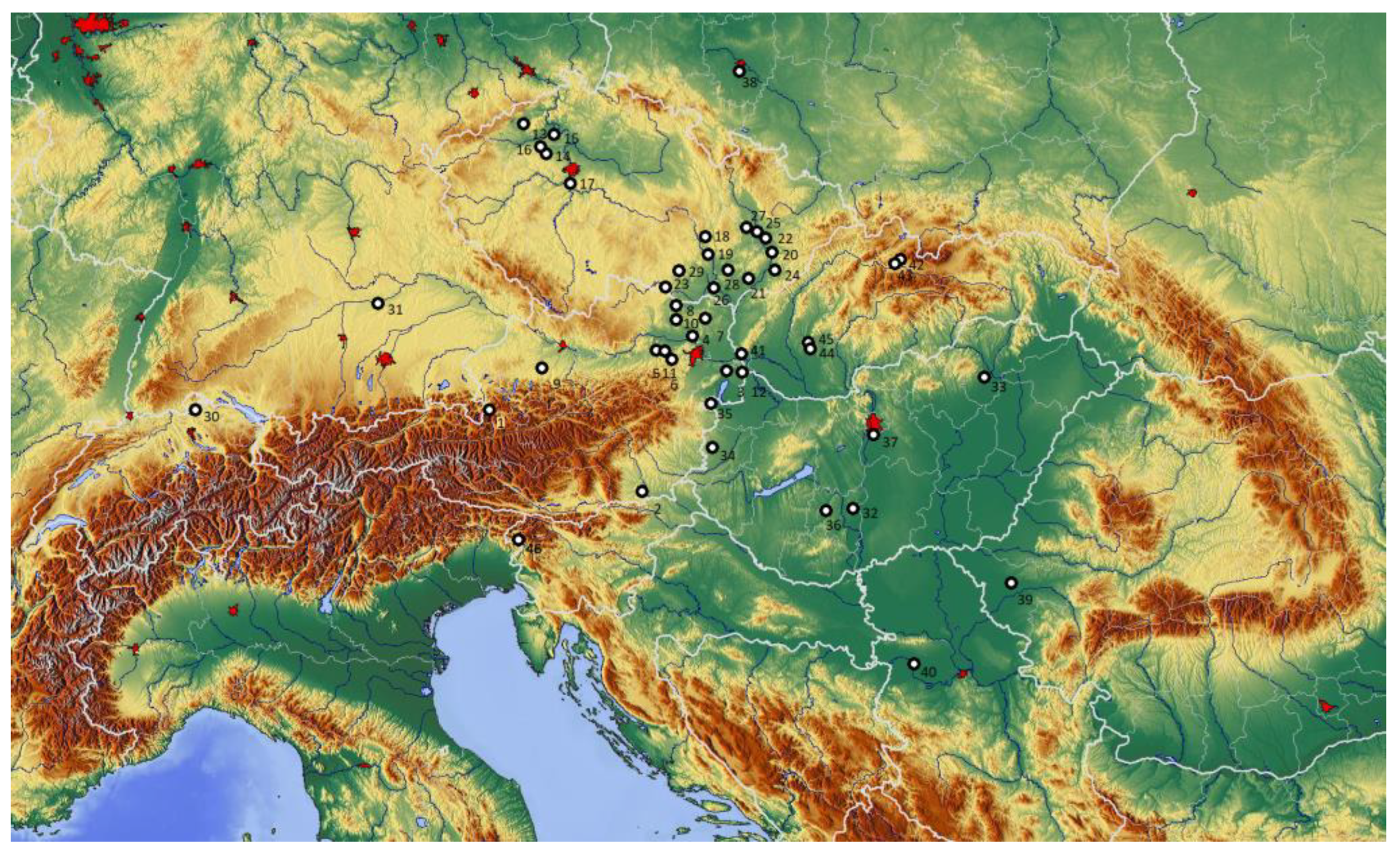
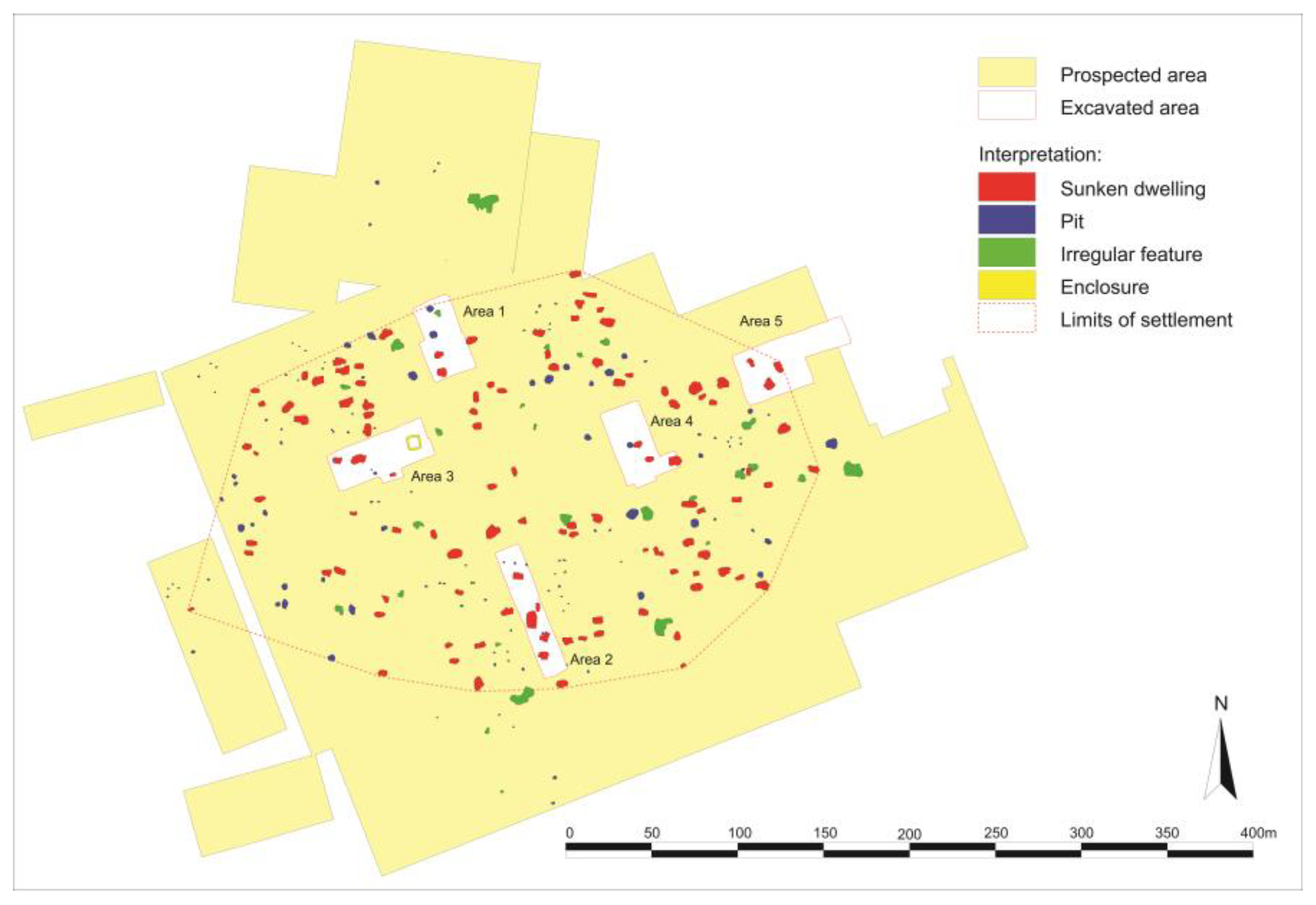
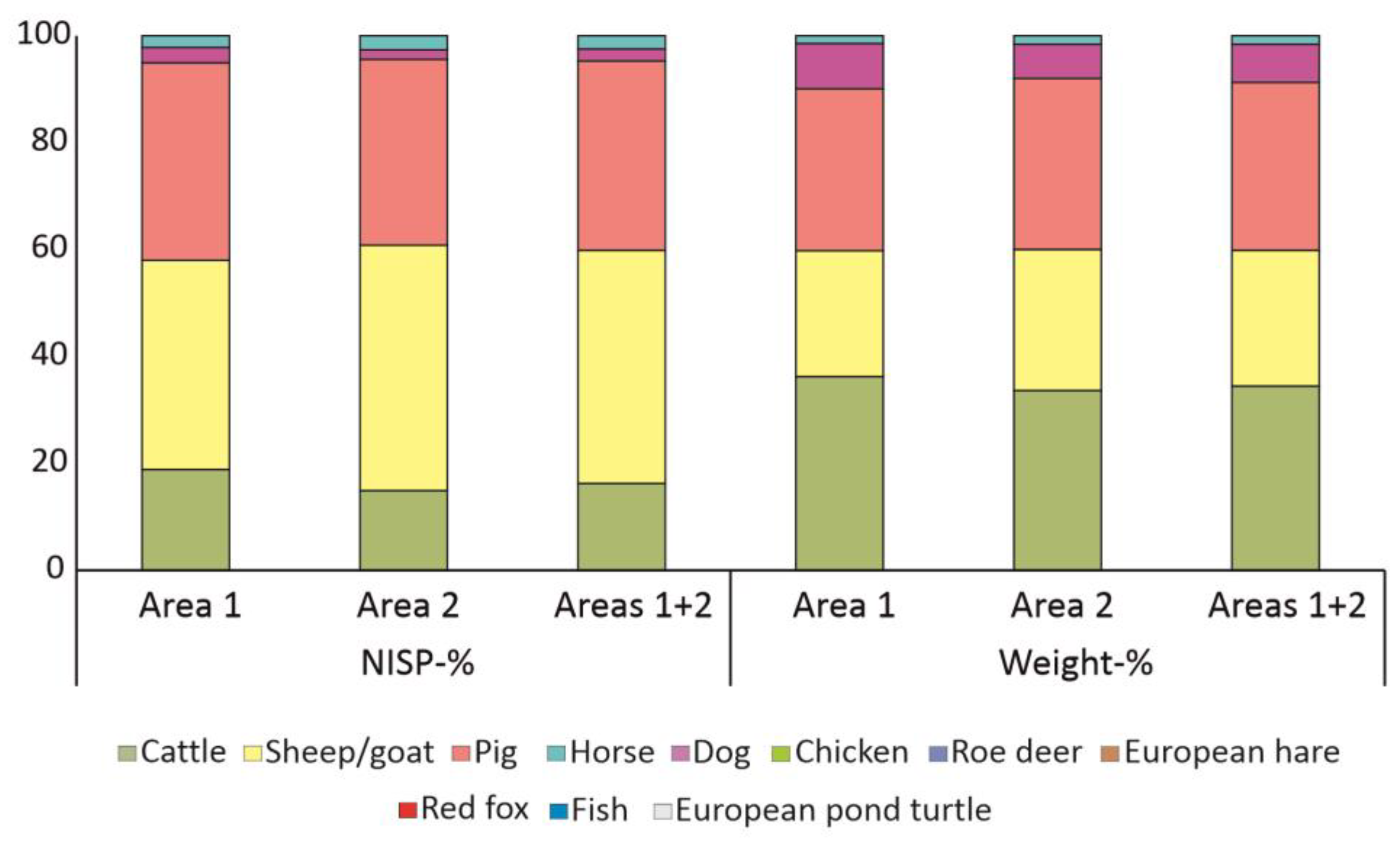
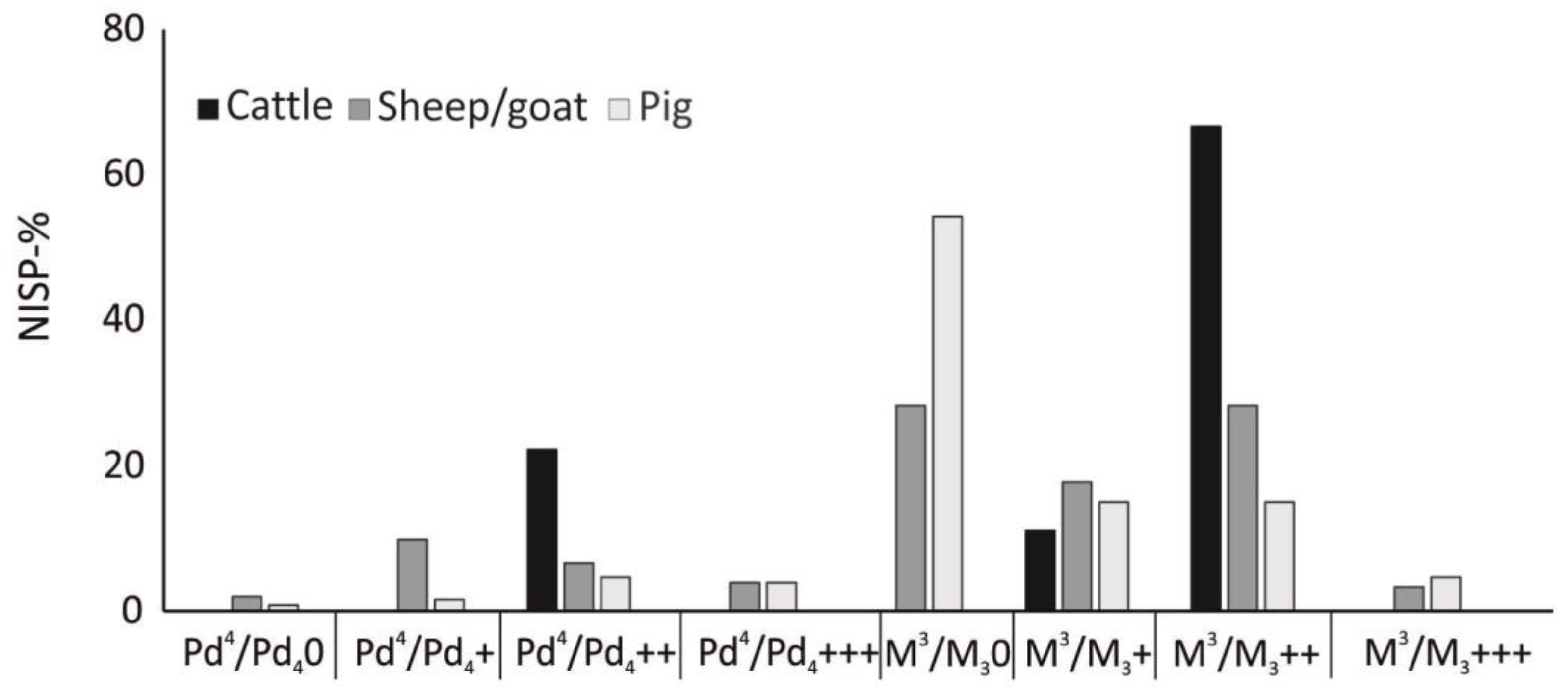
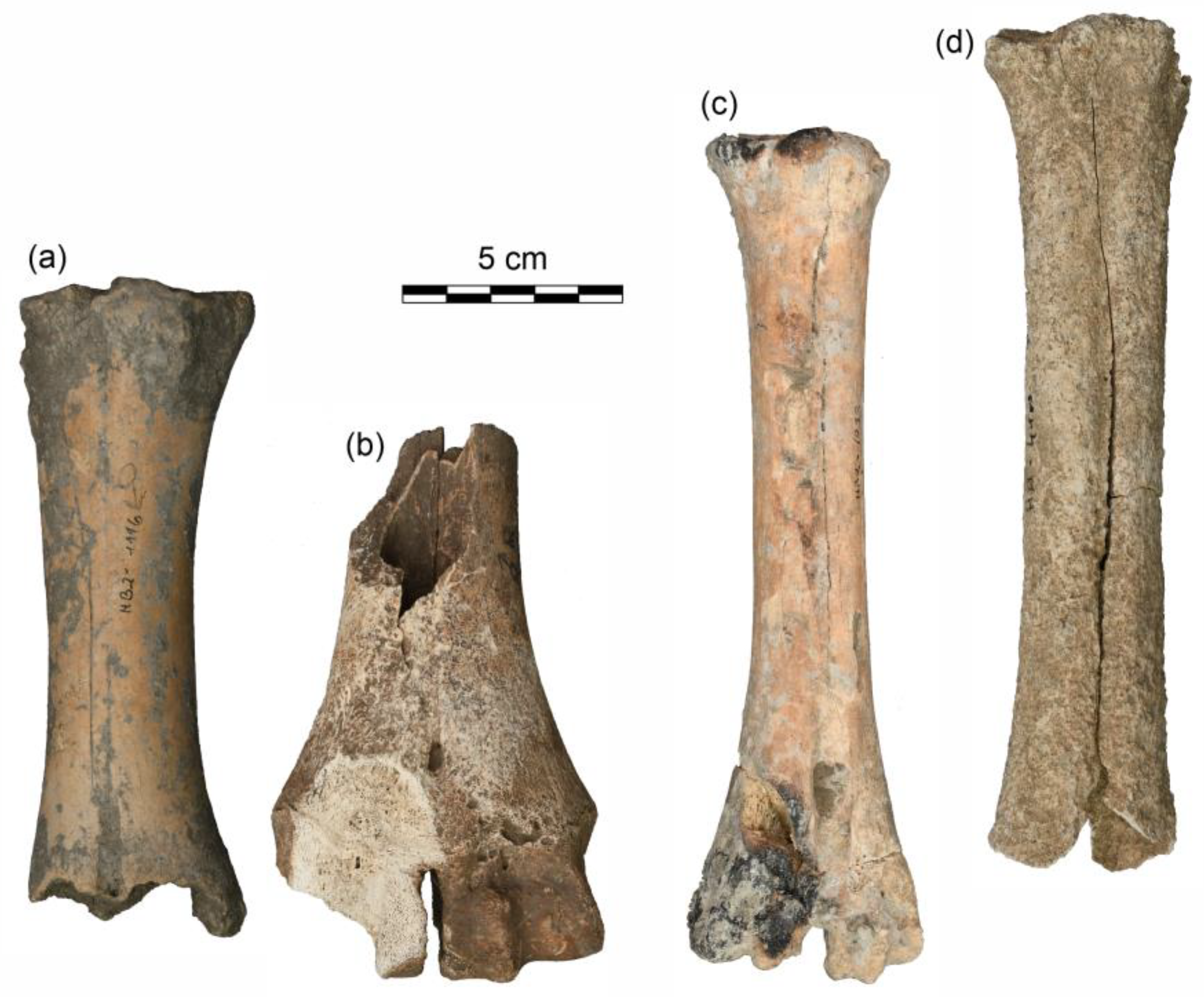
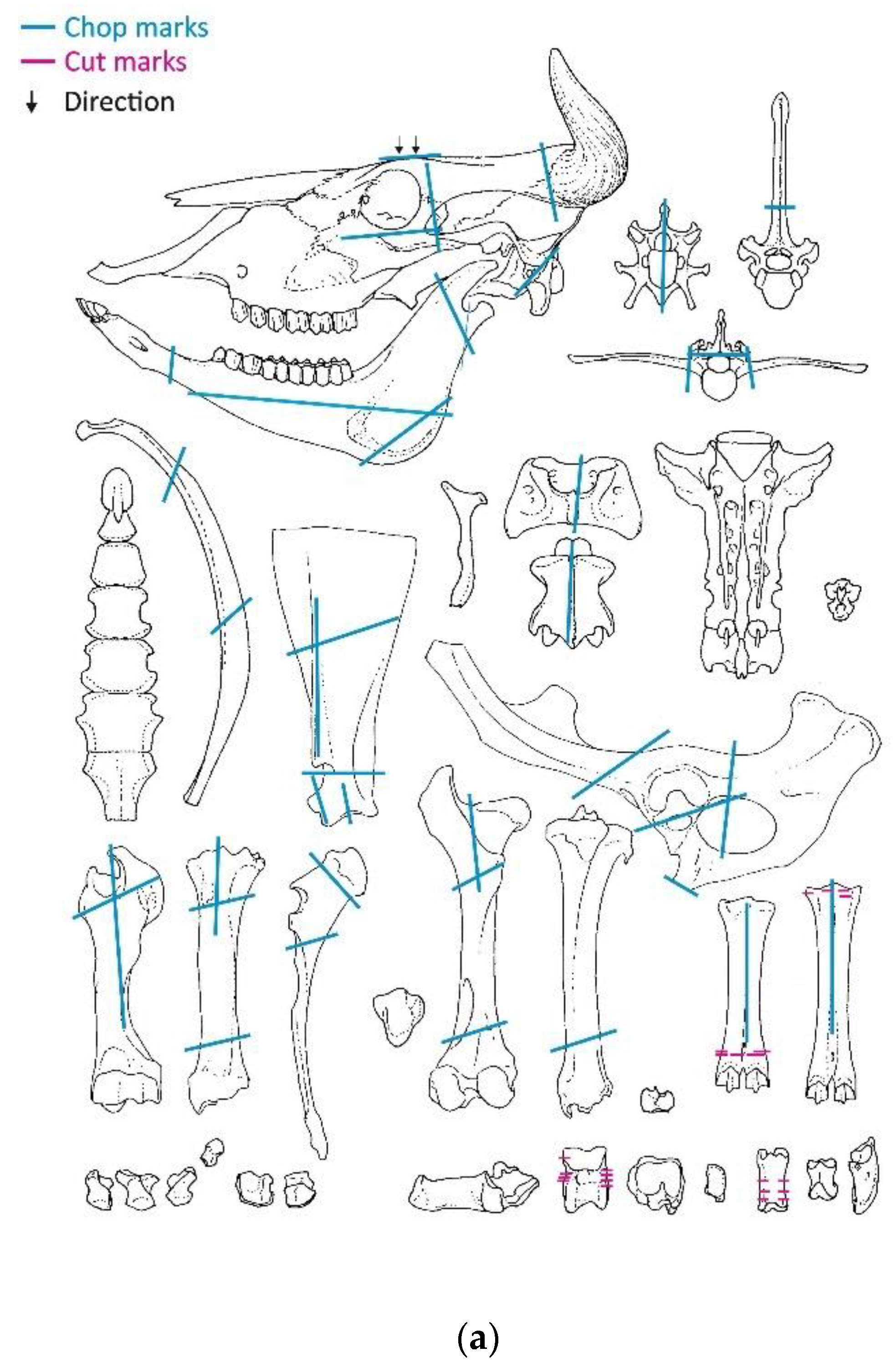
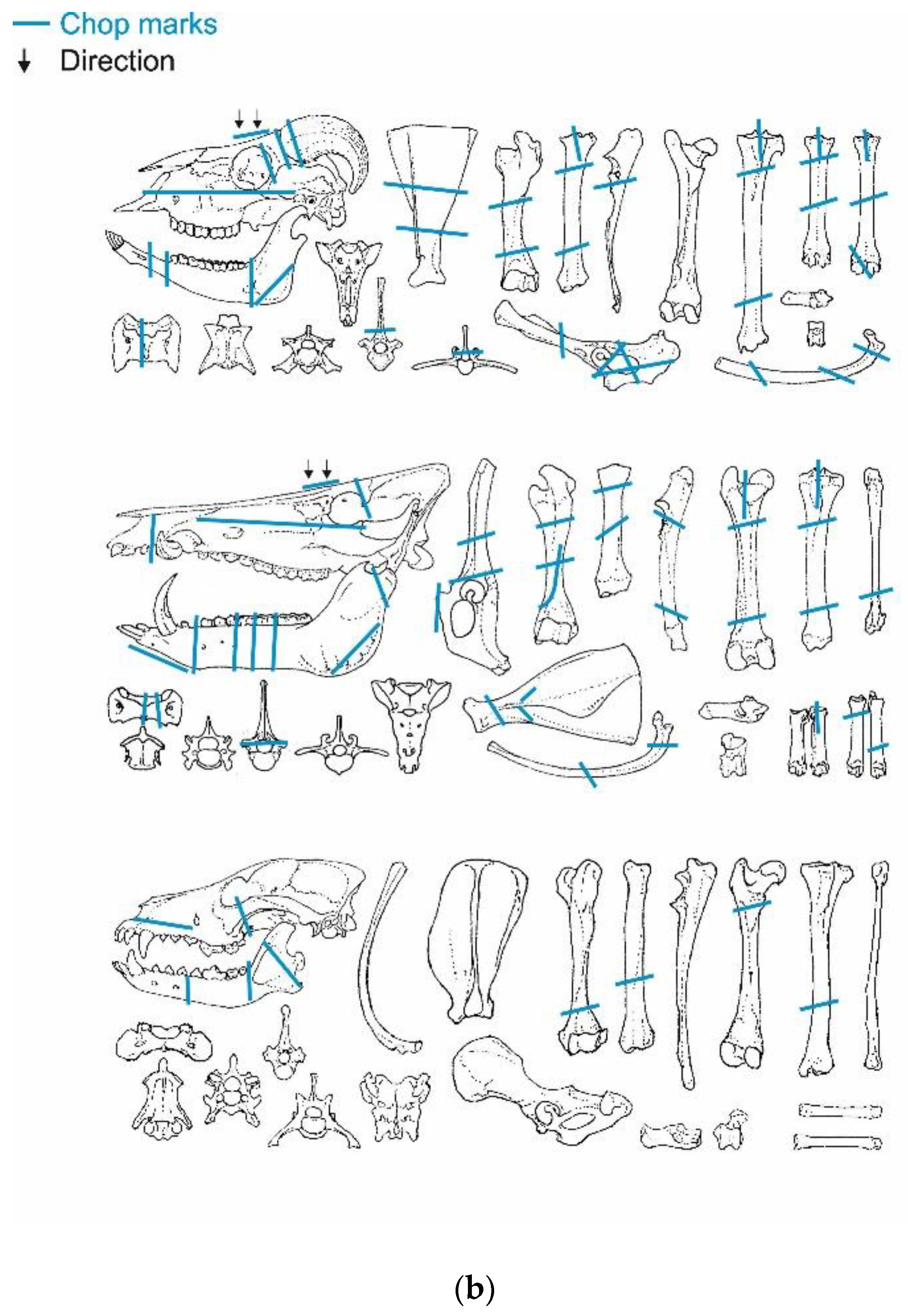
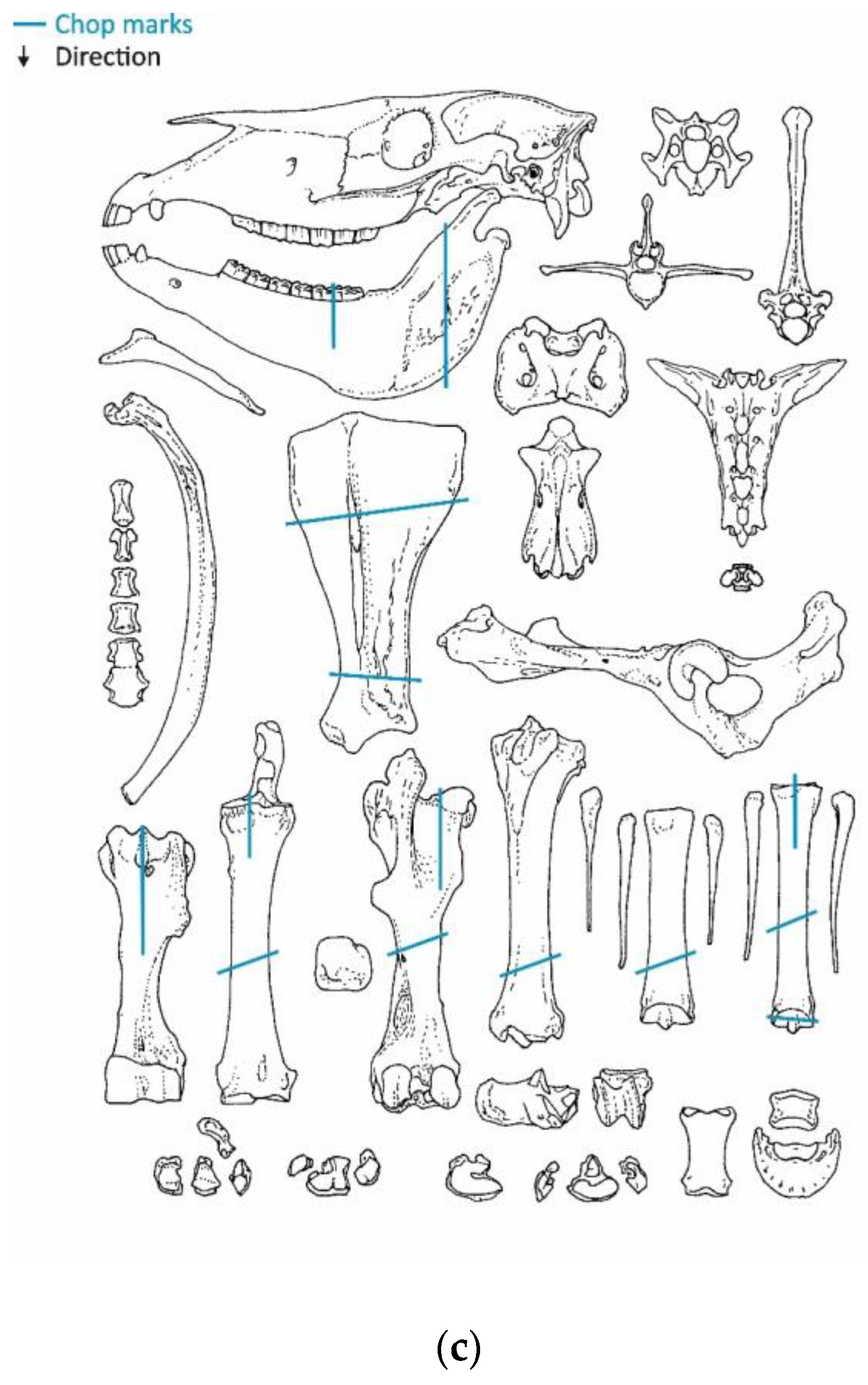
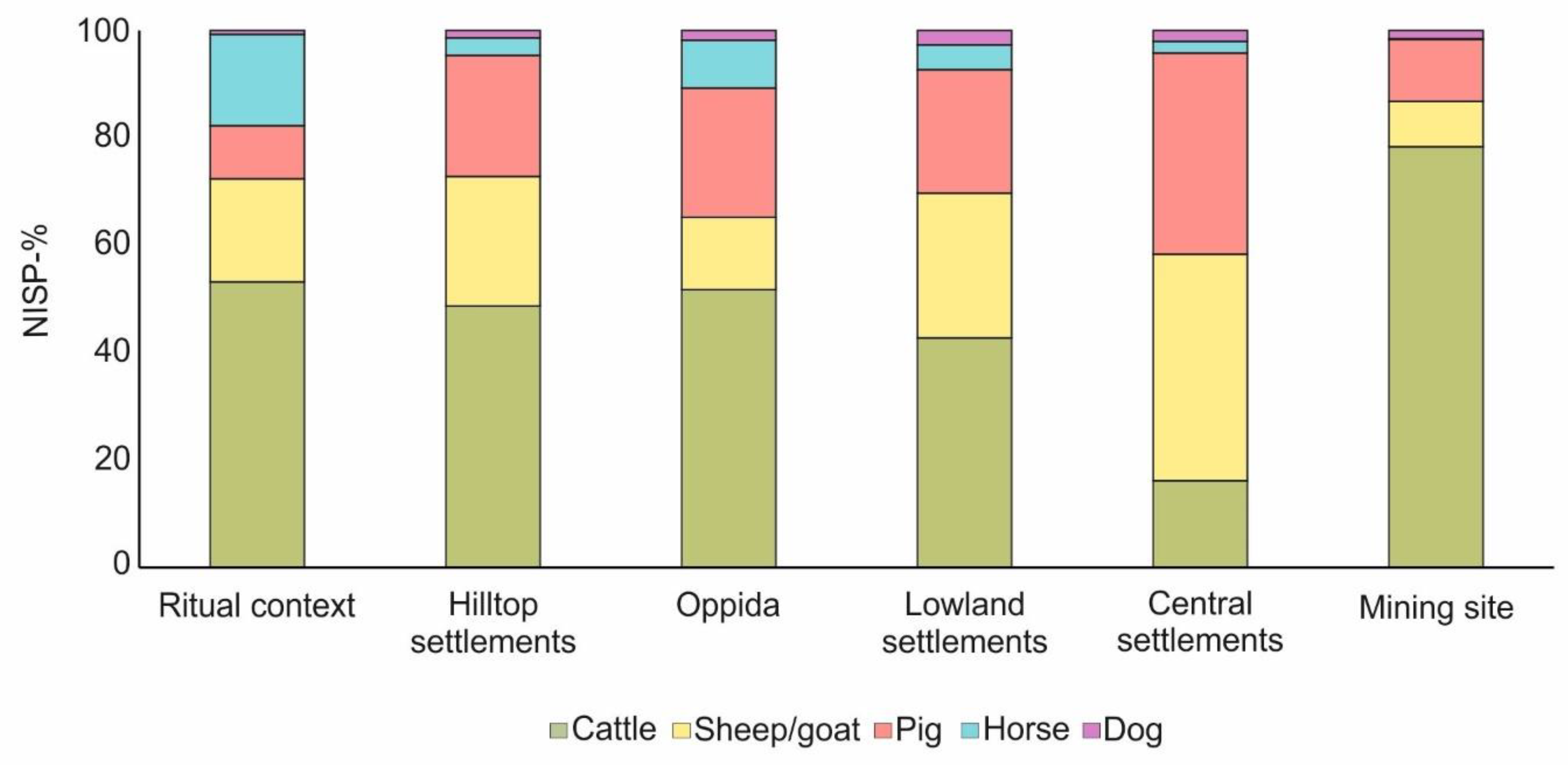
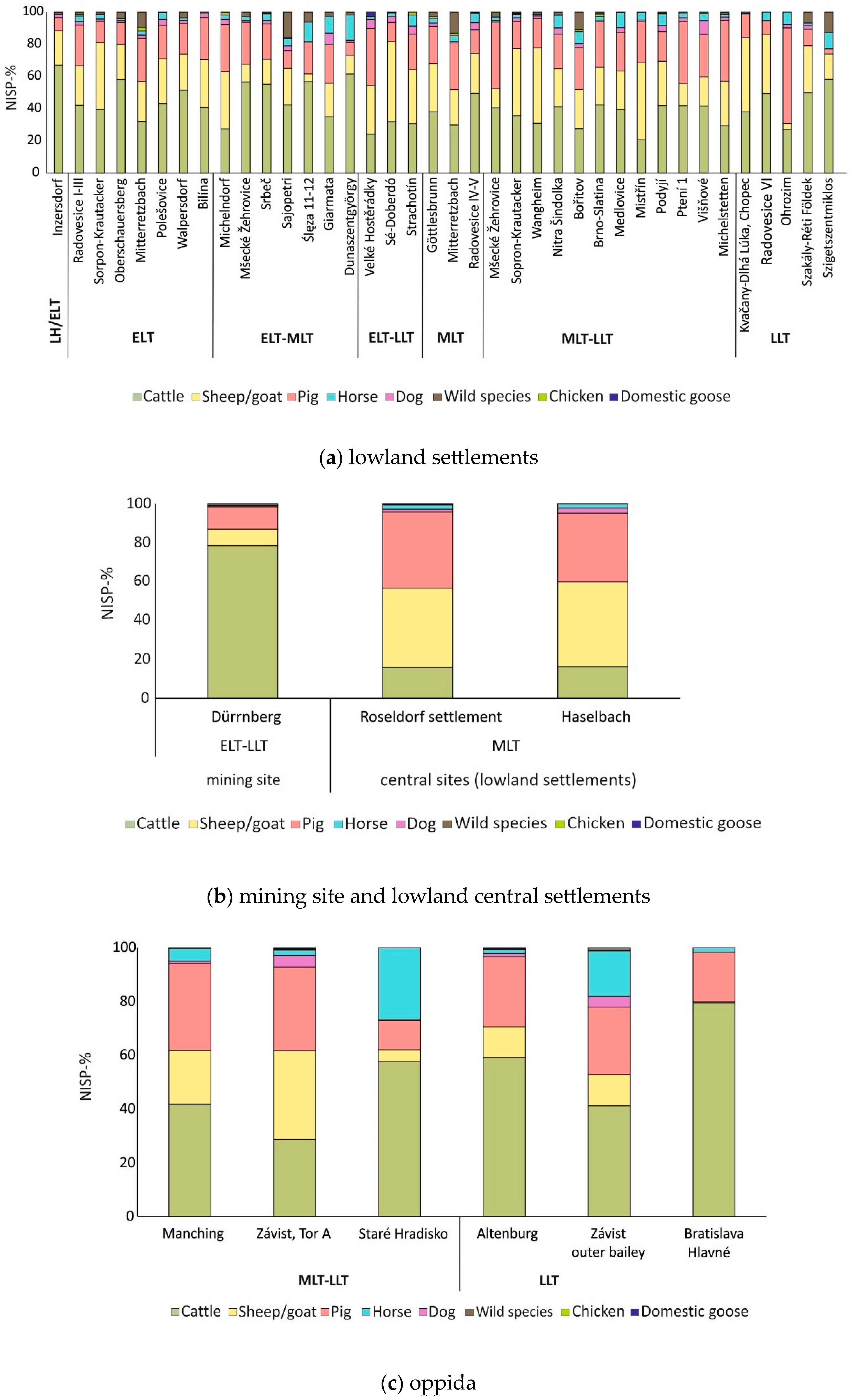
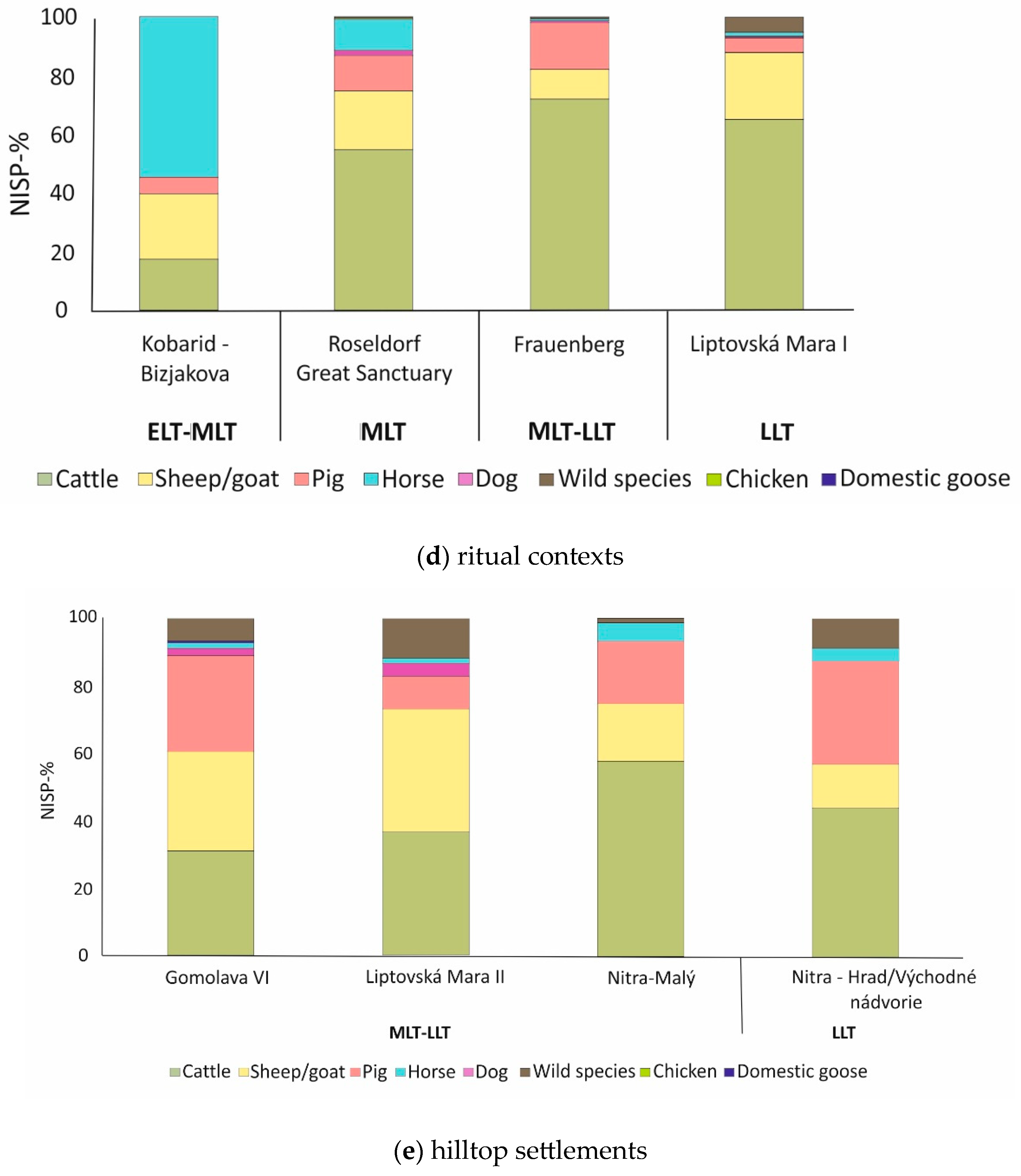
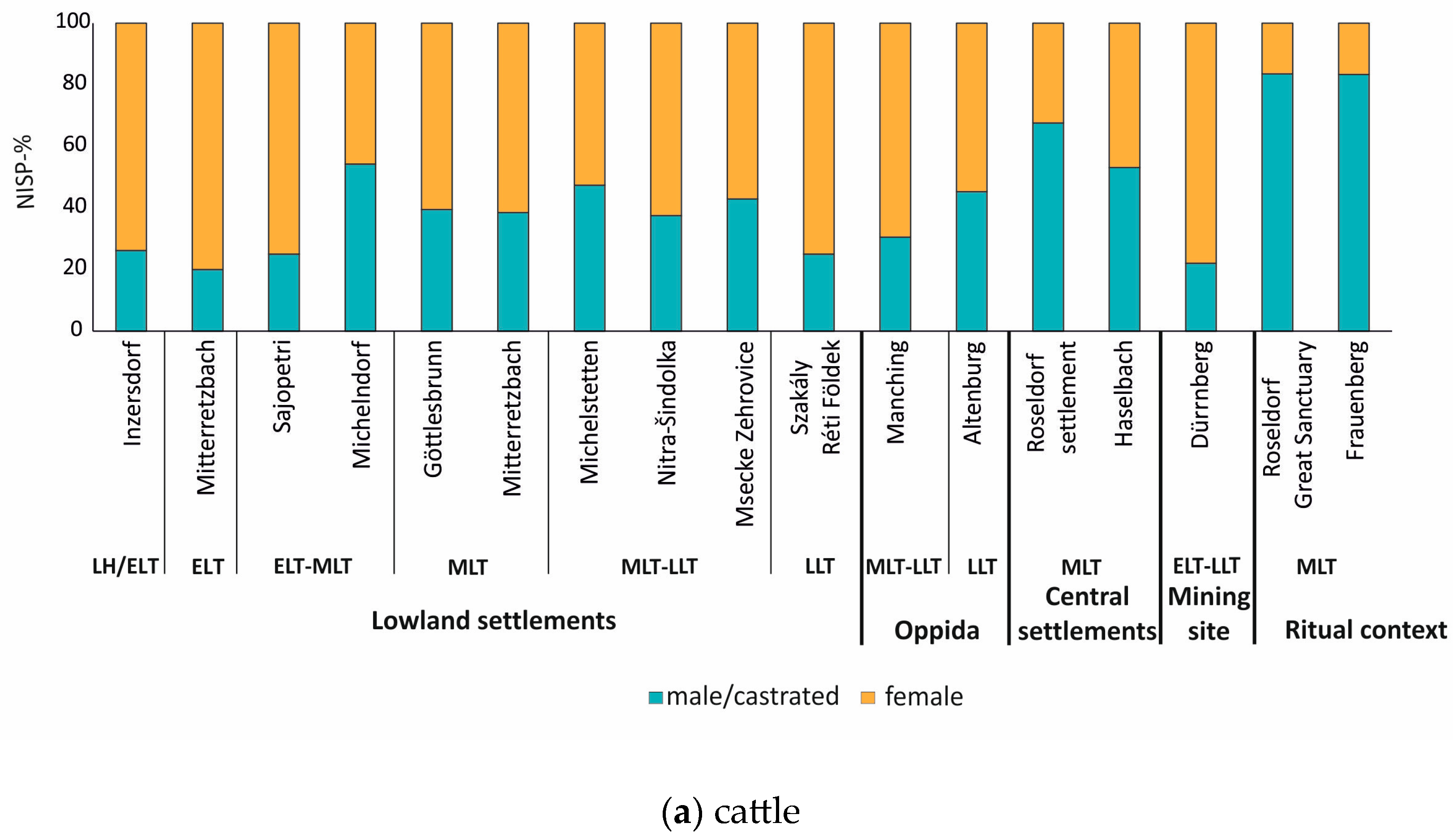
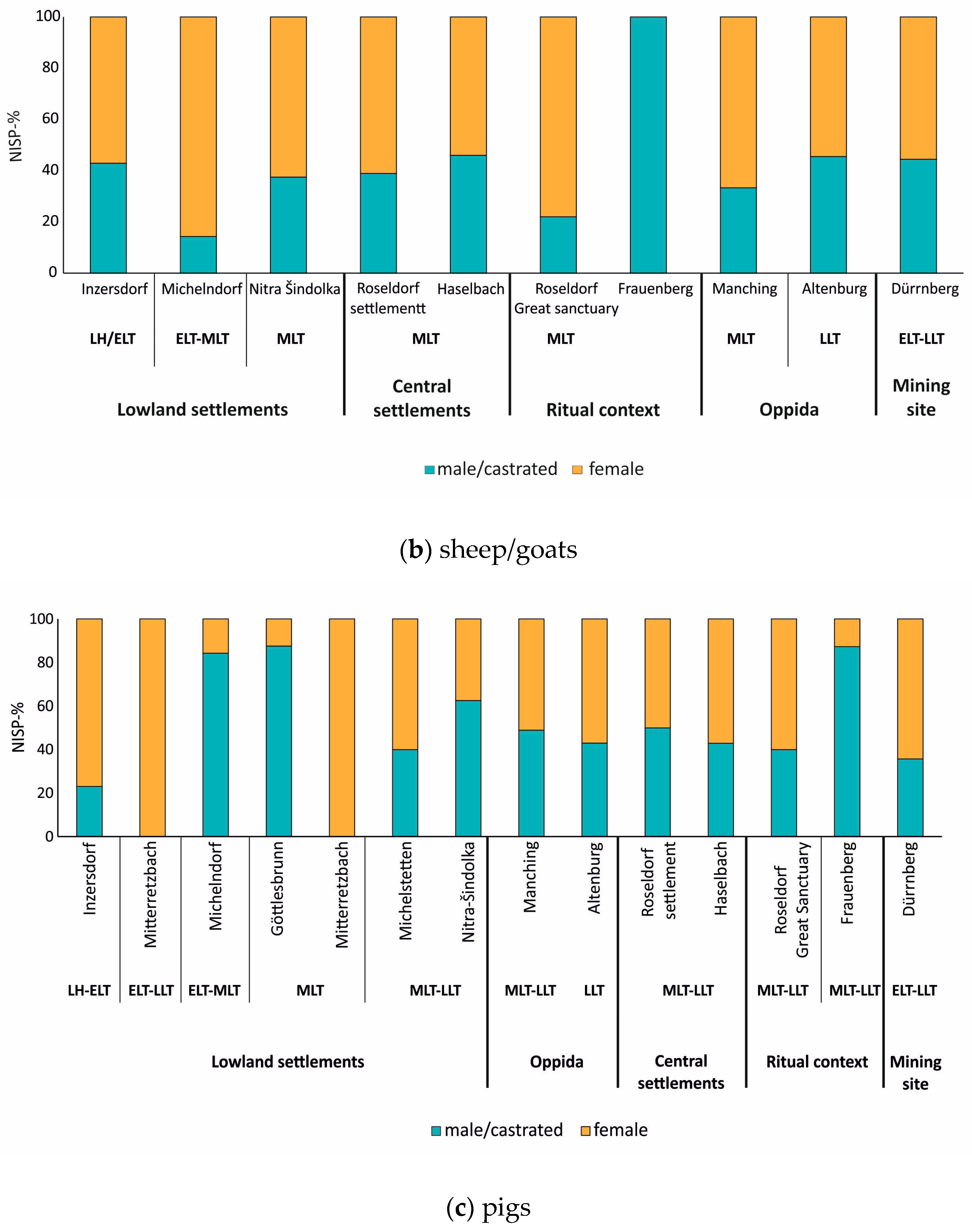
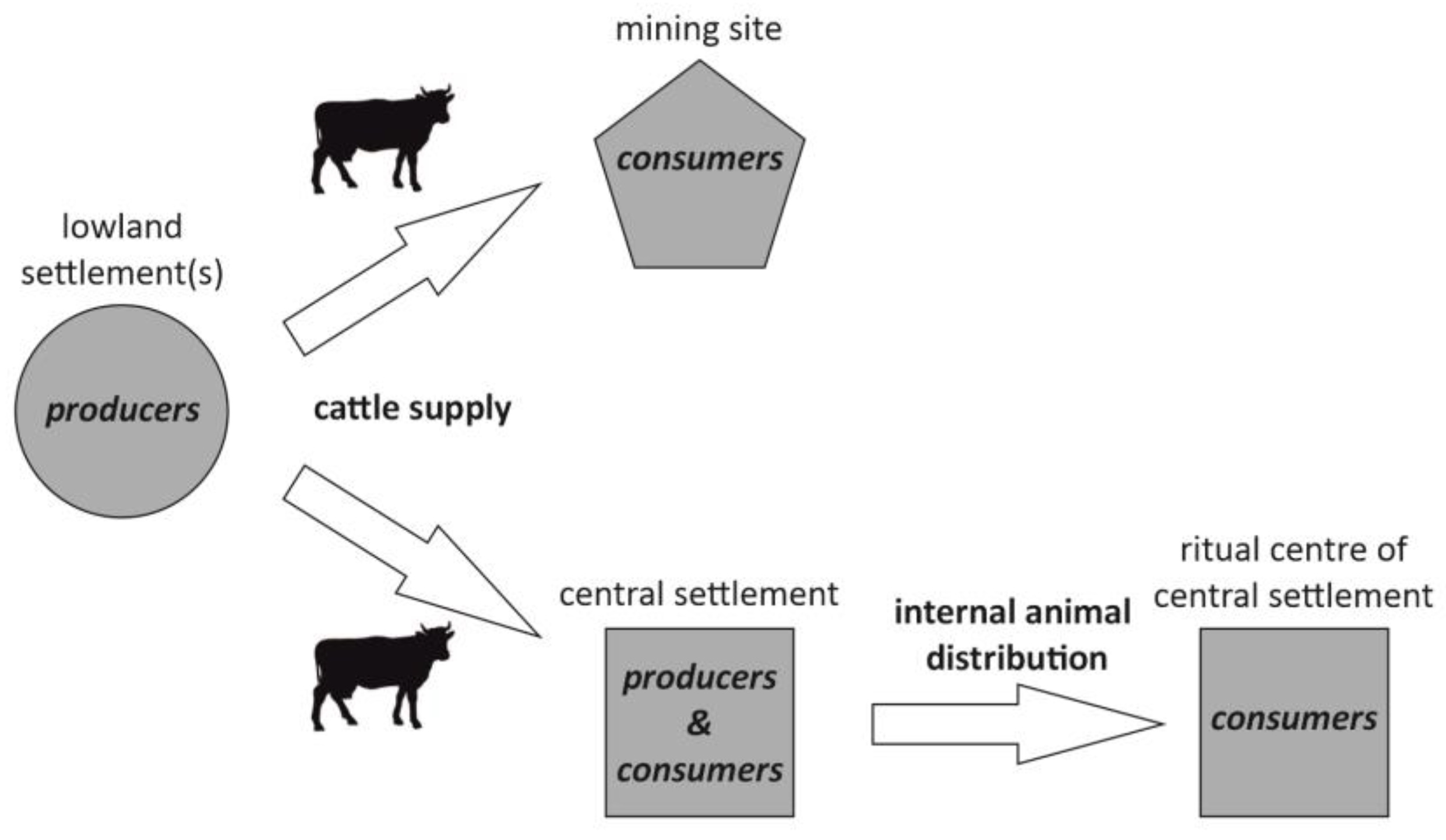
| Area 1—NISP | |||||||
|---|---|---|---|---|---|---|---|
| Element | Cattle | Sheep/Goat | Pig | Horse | Dog | European Hare | European Pond Turtle |
| Processus frontalis | 2 | 2 | - | - | - | - | - |
| Calva | 24 | 28 | 54 | - | 6 | - | - |
| Maxilla | 25 | 90 | 89 | 7 | 8 | - | - |
| Mandibula | 48 | 147 | 174 | 8 | 11 | - | - |
| Vertebrae | 36 | 25 | 18 | 1 | 3 | - | - |
| Costae | 58 | 161 | 48 | - | 1 | - | - |
| Scapula | 14 | 22 | 34 | 1 | 2 | - | - |
| Humerus | 20 | 49 | 53 | 5 | 2 | 1 | - |
| Radius | 19 | 56 | 24 | 2 | 4 | - | - |
| Ulna | 9 | 14 | 46 | - | 3 | - | - |
| Carpalia | 8 | 2 | - | - | - | - | - |
| Metacarpalia | 18 | 32 | 29 | 1 | 1 | - | - |
| Pelvis | 17 | 24 | 23 | - | - | - | - |
| Femur | 14 | 21 | 33 | 2 | 1 | - | - |
| Patella | 2 | 2 | - | - | - | - | - |
| Tibia | 23 | 72 | 41 | 3 | 2 | - | - |
| Fibula/Mall. | 1 | - | 11 | 2 | - | - | - |
| Talus | 3 | 10 | 11 | 2 | - | - | - |
| Calcaneus | 9 | 7 | 18 | - | 1 | - | - |
| Tarsalia | 3 | - | 4 | 3 | - | - | - |
| Metatarsalia | 11 | 32 | 24 | 2 | - | - | - |
| Metapodia | 5 | 8 | 11 | 6 | - | - | - |
| Phalanx 1 | 15 | 10 | 14 | 7 | 1 | - | - |
| Phalanx 2 | 8 | 8 | 11 | 3 | - | - | - |
| Phalanx 3 | 7 | 1 | 6 | 5 | - | - | - |
| Sesamoidea | - | - | - | 1 | - | - | - |
| Total | 399 | 823 | 776 | 61 | 46 | 1 | 1 |
| Area 2—NISP | |||||||||
|---|---|---|---|---|---|---|---|---|---|
| Element | Cattle | Sheep/Goat | Pig | Horse | Dog | Chicken | Roe Deer | Red fox | Fish |
| Processus frontalis | 5 | 29 | - | - | - | - | - | - | - |
| Calva | 41 | 62 | 106 | - | 5 | - | - | - | - |
| Maxilla | 21 | 117 | 153 | 3 | 16 | - | - | - | - |
| Mandibula | 54 | 258 | 262 | 10 | 21 | - | - | 1 | - |
| Vertebrae | 83 | 45 | 75 | 8 | 6 | - | - | - | - |
| Costae | 108 | 531 | 98 | 2 | - | - | - | - | - |
| Coracoid | - | - | - | - | - | 1 | - | - | - |
| Scapula | 32 | 56 | 62 | 4 | 6 | - | - | - | - |
| Humerus | 33 | 108 | 61 | - | 3 | 1 | - | - | - |
| Radius | 34 | 117 | 41 | 5 | 8 | - | - | - | - |
| Ulna | 8 | 33 | 54 | - | 7 | - | - | - | - |
| Carpalia | 10 | 2 | - | - | - | - | - | - | - |
| Metacarpalia | 18 | 78 | 70 | 3 | 5 | - | - | - | - |
| Pelvis | 18 | 65 | 50 | 9 | 1 | - | - | - | - |
| Femur | 23 | 41 | 74 | 5 | 1 | - | - | - | - |
| Patella | 2 | - | 2 | - | - | - | - | - | - |
| Tibia | 27 | 127 | 66 | 2 | 3 | - | 1 | - | - |
| Fibula/Mall. | - | - | 44 | 2 | - | - | - | - | - |
| Talus | 10 | 18 | 15 | 3 | - | - | - | - | - |
| Calcaneus | 12 | 15 | 29 | 3 | 1 | - | - | - | - |
| Tarsalia | 2 | 5 | 1 | 3 | - | - | - | - | - |
| Metatarsalia | 16 | 105 | 70 | 3 | 3 | - | - | - | - |
| Metapodia | 13 | 12 | 18 | 2 | 19 | - | - | - | - |
| Phalanx 1 | 16 | 22 | 29 | 4 | 1 | - | - | - | - |
| Phalanx 2 | 11 | 16 | 16 | 3 | - | - | - | - | - |
| Phalanx 3 | 9 | 6 | 19 | - | - | - | - | - | - |
| Total | 606 | 1868 | 1415 | 74 | 106 | 2 | 1 | 1 | 1 |
| Bos | Male | Male? | Castrated | Castrated? | Female | Female? |
|---|---|---|---|---|---|---|
| Processus frontalis | - | - | 2 | - | 5 | - |
| Pelvis | - | - | 4 | 1 | 6 | - |
| Metacarpus | 2 | 1 | 12 | 1 | 9 | - |
| Metatarsus | - | - | 11 | - | 6 | 2 |
| Crania | - | - | - | - | 2 | - |
| Total | 2 | 1 | 29 | 2 | 28 | 2 |
| Ovis | Male | Female |
|---|---|---|
| Processus frontalis | 13 | 15 |
| Pelvis | 22 | 26 |
| Total | 35 | 41 |
| Capra | male | female |
| Processus frontalis | 5 | 4 |
| Pelvis | - | 2 |
| Total | 5 | 6 |
| Sus | Male | Female | |
|---|---|---|---|
| Maxilla | Alveoli | 1 | 6 |
| Canini * | 30 | 24 | |
| Mandibula | Alveoli | 12 | 8 |
| Canini * | 53 | 34 | |
| Total | 96 | 72 |
| Nr. | Site/Assemblage | Country | Dating | Exact Dating | Type | Archaeozoological Literature |
|---|---|---|---|---|---|---|
| 1. | Dürrnberg | Austria | ELT-LLT | Salt mine | [73,74,75,76,77] | |
| 2. | Frauenberg near Leibnitz | Austria | M-LLT | LT C2-D | Sanctuary | [78] |
| 3. | Göttlesbrunn | Austria | MLT | LT C1-2 | Lowland settlement | [79] |
| 4. | Haselbach (Area 1–2) | Austria | MLT | LT B2-LT D1, main phase LT C | Lowland central settlement | present work |
| 5. | Inzersdorf | Austria | ELT | Ha D3/LT A to LT C | Lowland settlement | [80] |
| 6. | Michelndorf | Austria | ELT-MLT | LT B2-C2 | Lowland settlement | [81] |
| 7. | Michelstetten | Austria | M-LLT | LT C1-D1 | Lowland settlement | [82] |
| 8. | Mitterretzbach | Austria | ELT | - | Lowland settlement | [83] |
| MLT | ||||||
| 9. | Oberschauersberg | Austria | ELT | LT A | Lowland settlement | [84] |
| 10. | a. Roseldorf-settlement | Austria | MLT | - | Lowland central settlement | [85] |
| b. Roseldorf-Great Sanctuary (Object 1) | - | Sanctuary | [86] | |||
| 11. | Walpersdorf-Nord | Austria | ELT | - | Lowland settlement | [80] |
| 12. | Wangheim | Austria | M-LLT | - | Lowland settlement | [87] |
| 13. | Bilína | Czech Republic (Bohemia) | ELT | LT B1a | Lowland settlement | [88] |
| 14. | Mšecké Žehrovice | Czech Republic (Bohemia) | E-MLT | LT B2-C1 | Lowland settlement | [89] |
| M-LLT | LT C2-D1 | Lowland settlement (quadrangular enclosure) | ||||
| 15. | a. Radovesice I-III | Czech Republic (Bohemia) | ELT | Ha D-LT B1 | Lowland settlement | [90] |
| b. Radovesice IV-V | MLT | LTB2-LTC/D | ||||
| c. Radovesice VI | LLT | LT D | ||||
| 16. | Srbeč | Czech Republic (Bohemia) | E-MLT | LT B2-C1 | Lowland settlement | [91] |
| 17. | a. Závist, Gate A, Hor. II-V | Czech Republic (Bohemia) | M-LLT | LT C2-D2 | Oppidum | [92] |
| b. Závist-Outer bailey | LLT | LT D1 | Oppidum (outer bailey) | [93] | ||
| 18. | Bořitov | Czech Republic (Moravia) | M-LLT | LT C2-D1/D2 | Lowland settlement | [94] |
| 19. | Brno-Slatina | Czech Republic (Moravia) | M-LLT | LT C-D1 | Lowland settlement | [70] |
| 20. | Medlovice | Czech Republic (Moravia) | - | - | Lowland settlement | [70] |
| 21. | Mistřín | Czech Republic (Moravia) | - | - | Lowland settlement | [70] |
| 22. | Ohrozim | Czech Republic (Moravia) | LLT | - | Lowland settlement | [70] |
| 23. | Podyjí | Czech Republic (Moravia) | - | - | Lowland settlement | [70] |
| 24. | Polešovice | Czech Republic (Moravia) | ELT | - | Lowland settlement | [95] |
| 25. | Ptení 1 | Czech Republic (Moravia) | - | - | Lowland settlement | [70] |
| 26. | Strachotín | Czech Republic (Moravia) | - | - | Lowland settlement | [96] |
| 27. | Staré Hradisko | Czech Republic (Moravia) | M-LLT | LT C2-D | Oppidum | [97] |
| 28. | Velké Hostěrádky | Czech Republic (Moravia) | E-LLT | LTB-D | Lowland settlement | [98] |
| 29. | Višňové | Czech Republic (Moravia) | - | - | Lowland settlement | [70] |
| 30. | Altenburg-Rheinau | Germany | LLT | Oppidum | [99] | |
| 31. | Manching | Germany | M-LLT | LTC-D1 | Oppidum | [100] |
| 32. | Dunaszentgyörgy | Hungary | E-MLT | LT B2-C1 | Lowland settlement | [101] |
| 33. | Sajópetri | Hungary | E-MLT | LT B2-C1 | Lowland settlement | [102] |
| 34. | Sé-Doberdó | Hungary | E-LLT | Ha D-LT D | Lowland settlement | [103] |
| 35. | Sopron-Krautacker | Hungary | ELT | Ha D-LT A | Lowland settlement | [104] |
| M-LLT | LT B-LT D | |||||
| 36. | Szakály-Réti Földek | Hungary | LT | - | Lowland settlement | [105] |
| 37. | Szigetszentmiklos | Hungary | LLT | LT D | Lowland settlement | [106] |
| 38. | Ślęza 11–12 | Poland | E-MLT | LT B2-C1 | Lowland settlement | [72] |
| 39. | Giarmata | Romania | E-MLT | LT B2-C | Lowland settlement | [107] |
| 40. | Gomolava VI | Serbia | M-LLT | LT C2-D | Hilltop settlement | [108] |
| 41. | Bratislava-Hlavné námestie 7 | Slovakia | LLT | LT D2 | Oppidum-(outer bailey) | [71] |
| 42. | Kvačany-Dlhá Lúka | Slovakia | M-LLT | LT C-D | Lowland settlement | [71] |
| 43. | a. Liptovská Mara I | Slovakia | LLT | LT D1-D2 | Sanctuary | [71,109] |
| b. Liptovská Mara II | Slovakia | M-LLT | (Ha D1-LT B to C2) main phase: LT C2 | Hilltop settlement | [71,109] | |
| 44. | a. Nitra-Hrad/Východné nádvorie | Slovakia | LLT | LT D | Hilltop settlement | [71] |
| b. Nitra-Malý Seminár | Slovakia | LLT | LT D | Hilltop settlement | [71,110] | |
| 45. | Nitra Šindolka | Slovakia | M-LLT | LTC2-D1 | Lowland settlement | [71,111] |
| 46. | Kobarid-Bizjakova hiša | Slovenia | E-MLT | LT B2-C | Ritual site | [112] |
| Cattle—Height at Withers (cm) | |||||
|---|---|---|---|---|---|
| Site | Min | Max | Element | N | References |
| Dürrnberg-Ramsautal (female) | 94.8 | 111.1 | Mp | 58 | [73] |
| Dürrnberg-Ramsautal (castrated) | 103.2 | 122.5 | Mp | 33 | [73] |
| Gomolava | 101.0 | 125.0 | Mc | 9 | [108] |
| Gomolava | 92.0 | 116.5 | Mt | 9 | [108] |
| Haselbach (female) | 106.7 | 111.0 | Mc | 2 | present study |
| Haselbach (castrated) | 98.3 | 113.1 | Mp | 5 | present study |
| Inzersdorf-Walpersdorf (female) | 104.0 | 107.1 | Mp | 4 | [80] |
| Mšecké Žehrovice (LTC2-D1) | 103.8 | 112.5 | Mc | 5 | [89] |
| Mšecké Žehrovice (LTC2-D1) | 99.6 | 103.4 | Mt | 2 | [89] |
| Roseldorf-settlement (castrated) | 106.6 | 116.2 | Mp | 7 | [85] |
| Roseldorf-Great Sanctuary (female) | 105.8 | 108.2 | Mp | 5 | [86] |
| Roseldorf-Great Sanctuary (castrated) | 100.1 | 117.1 | Mp | 27 | [86] |
| Element/Site | Measurement | Min | Max | Average | N | References |
|---|---|---|---|---|---|---|
| Scapula | SLC | |||||
| Dürrnberg-Ramsautal | 34.0 | 54.0 | 42.6 | 81 | [73] | |
| Göttlesbrunn | 40.0 | 53.5 | 46.6 | 9 | [79] | |
| Haselbach | 33.0 | 51.5 | 45.4 | 8 | present study | |
| Roseldorf-Great Sanctuary | 41.5 | 57.5 | 49.7 | 32 | [86] | |
| Radius | Bp | |||||
| Dürrnberg-Ramsautal | 61.5 | 83.0 | 69.0 | 101 | [73] | |
| Haselbach | 54.0 | 78.5 | 70.1 | 9 | present study | |
| Roseldorf-Great Sanctuary | 68.5 | 86.5 | 77.7 | 43 | [86] | |
| Metacarpus | Bp | |||||
| Dürrnberg Ramsautal | 43.5 | 59.5 | 48.8 | 68 | [73] | |
| Haselbach | 38.5 | 60.5 | 50.3 | 17 | present study | |
| Roseldorf-Great Sanctuary (female) | 45.5 | 52.0 | 48.3 | 6 | [86] | |
| Roseldorf-Great Sanctuary (castrated) | 48.5 | 61.5 | 55.7 | 47 | [86] | |
| Tibia | Bd | |||||
| Dürrnberg-Ramsautal | 45.5 | 63.5 | 53.2 | 175 | [73] | |
| Göttlesbrunn | 50.5 | 62.0 | 56.2 | 6 | [79] | |
| Haselbach | 48.5 | 60.0 | 55.0 | 12 | present study | |
| Roseldorf-Great Sanctuary | 51.5 | 65.0 | 58.1 | 80 | [86] | |
| Talus | GLl | |||||
| Dürrnberg-Ramsautal | 48.0 | 64.5 | 57.4 | 191 | [73] | |
| Göttlesbrunn | 46.0 | 61.5 | 53.5 | 26 | [79] | |
| Inzersdorf-Walpersdorf | 54.5 | 63.5 | 60.0 | 11 | [80] | |
| Haselbach | 54.0 | 58.0 | 56.1 | 8 | present study | |
| Roseldorf-Great Sanctuary | 55.0 | 67.0 | 60.3 | 60 | [86] | |
| Metatarsus | Bp | |||||
| Dürrnberg-Ramsautal | 35.0 | 50.5 | 40.8 | 78 | [73] | |
| Haselbach | 37.5 | 49.5 | 44.4 | 10 | present study | |
| Roseldorf-Great Sanctuary (female) | 37.5 | 44.5 | 40.9 | 13 | [86] | |
| Roseldorf-Great Sanctuary (castrated) | 41.5 | 48.0 | 44.5 | 38 | [86] | |
| Phalanx 1 | Glpe | |||||
| Dürrnberg-Ramsautal | 43.0 | 58.5 | 52.0 | 185 | [73] | |
| Inzersdorf-Walpersdorf | 50.0 | 58.5 | 53.3 | 12 | [80] | |
| Haselbach | 48.5 | 58.0 | 52.8 | 20 | present study | |
| Roseldorf-Great Sanctuary | 47.0 | 59.0 | 54.0 | 39 | [86] |
| Sheep–Height at Withers (cm) | ||||
|---|---|---|---|---|
| Site | N | Average | Range of Variation | References |
| Dürrnberg-Ramsautal | 25 | 65.6 | 57.2–77.1 | [73] |
| Göttlesbrunn | 7 | 61.0 | 56.1–65.0 | [79] |
| Inzersdorf-Walpersdorf | 9 | 59.9 | 56.9–64.1 | [80] |
| Haselbach | 41 | 61.9 | 52.1–68.7 | present study |
| Michelstetten | 9 | 62.5 | 57.2–67.3 | [82] |
| Roseldorf-Great Sanctuary | 9 | 63.9 | 61.2–67.2 | [86] |
| Roseldorf-settlement | 19 | 61.3 | 59.8–63.1 | [85] |
| Sheep–Humerus Bd (mm) | |||||
|---|---|---|---|---|---|
| Site | N | Min | Max | Average | References |
| Dürrnberg-Ramsautal | 36 | 27.5 | 39.0 | 30.5 | [73] |
| Göttlesbrunn | 5 | 28.5 | 31.0 | 29.8 | [79] |
| Inzersdorf-Walpersdorf | 8 | 26.5 | 32.0 | 28.9 | [80] |
| Haselbach | 46 | 27.0 | 35.0 | 30.5 | present study |
| Nitra Šindolka | 6 | 25.8 | 31.2 | 28.2 | [111] |
| Roseldorf-settlement | 17 | 27.0 | 33.5 | 30.1 | [85] |
| Roseldorf-Great Sanctuary | 12 | 28.5 | 33.0 | 30.3 | [86] |
| Pig—Height at Withers (cm) | ||||
|---|---|---|---|---|
| Site | N | Average | Range of Variation | References |
| Dürrnberg-Ramsautal | 15 | 75.0 | 67.0–81.0 | [73] |
| Göttlesbrunn | 8 | 77.2 | 69.8–83.6 | [79] |
| Inzersdorf-Walpersdorf | 4 | 78.0 | 71.0–82.0 | [80] |
| Haselbach | 11 | 70.9 | 65.1–78.4 | present study |
| Michelstetten | 8 | 76.8 | 74.0–80.6 | [82] |
| Roseldorf-Great Sanctuary | 19 | 72.8 | 60.9–82.0 | [86] |
| Roseldorf-settlement | 17 | 74.4 | 70.3–78.0 | [85] |
| Pig—Tibia Bd (mm) | |||||
|---|---|---|---|---|---|
| Site | N | Min | Max | Average | References |
| Dürrnberg-Ramsautal | 46 | 24.5 | 30.5 | 27.8 | [73] |
| Gomolava | 4 | 25.0 | 27.0 | 26.4 | [108] |
| Göttlesbrunn | 5 | 25.0 | 30.0 | 28.0 | [79] |
| Inzersdorf-Walpersdorf | 5 | 26.5 | 30.0 | 28.4 | [80] |
| Haselbach | 24 | 25.5 | 31.5 | 28.7 | present study |
| Mšecké Žehrovice (LTC2-D1) | 5 | 26.0 | 29.5 | 27.4 | [89] |
| Roseldorf-settlement | 42 | 26.5 | 30.5 | 28.3 | [85] |
| Dog: Length of the Cheektooth Row (M3–P1) (mm) | |||||
|---|---|---|---|---|---|
| Site | Min | Max | X | N | References |
| Dürrnberg-Ramsautal | 67.5 | 80.5 | 75.3 | 6 | [73] |
| Gomolava | 59.0 | 77.0 | 65.9 | 14 | [108] |
| Haselbach | 68.5 | 79.5 | 75.1 | 14 | present study |
| Manching | 54.0 | 80.0 | 69.4 | 66 | [100] |
| Michelstetten | 68.0 | 82.0 | 73.2 | 3 | [82] |
| Nitra Šindolka | 68.3 | 82.3 | 73.8 | 11 | [111] |
| Roseldorf-Great Sanctuary | 57.5 | 76.5 | 69.5 | 10 | [86] |
| Roseldorf-settlement | 55.4 | 81.0 | 72.2 | 4 | [85] |
Disclaimer/Publisher’s Note: The statements, opinions and data contained in all publications are solely those of the individual author(s) and contributor(s) and not of MDPI and/or the editor(s). MDPI and/or the editor(s) disclaim responsibility for any injury to people or property resulting from any ideas, methods, instructions or products referred to in the content. |
© 2023 by the authors. Licensee MDPI, Basel, Switzerland. This article is an open access article distributed under the terms and conditions of the Creative Commons Attribution (CC BY) license (https://creativecommons.org/licenses/by/4.0/).
Share and Cite
Saliari, K.; Trebsche, P. Cattle Make the Difference: Variations and Developments of Animal Husbandry in the Central European La Tène Culture. Animals 2023, 13, 1847. https://doi.org/10.3390/ani13111847
Saliari K, Trebsche P. Cattle Make the Difference: Variations and Developments of Animal Husbandry in the Central European La Tène Culture. Animals. 2023; 13(11):1847. https://doi.org/10.3390/ani13111847
Chicago/Turabian StyleSaliari, Konstantina, and Peter Trebsche. 2023. "Cattle Make the Difference: Variations and Developments of Animal Husbandry in the Central European La Tène Culture" Animals 13, no. 11: 1847. https://doi.org/10.3390/ani13111847
APA StyleSaliari, K., & Trebsche, P. (2023). Cattle Make the Difference: Variations and Developments of Animal Husbandry in the Central European La Tène Culture. Animals, 13(11), 1847. https://doi.org/10.3390/ani13111847








